 [Klik hier voor de Nederlandse versie]
[Klik hier voor de Nederlandse versie]
Two years ago it was the first time I went to Switzerland with my 100% electric Renault Zoe. 900km one way was a real challenge because back then there were no fast chargers. It made me happy if there was a semi-fast charger (22kW) on the route. This way I could not drive more than 350km per day. The next year there were some fast chargers and it was possible to make an entire tour of almost 2400km through Switzerland.
This year I set the bar higher, and the outward journey is already 2000km! Now I will mostly use fast chargers, and cover 550km per day. Seven different charge cards or phone Apps have been arranged. Hopefully they all will work, because I wasn’t able to test most of them. Furthermore, I will not use ferries on this trip, but drive entirely over bridges in Denmark and Sweden to Geiranger (Norway), where among other things I will attend the 20th anniversary of the Norwegian electric car association.
24-8-2015 Gennep – Lübeck [575 km]
 I am facing a dilemma. 5 years ago I grew a new pineapple plant out of the crown of a pineapple. All that time I’ve taken good care of it. So good, it resulted in growing a flower half a year ago, from which a real new pineapple has grown.
I am facing a dilemma. 5 years ago I grew a new pineapple plant out of the crown of a pineapple. All that time I’ve taken good care of it. So good, it resulted in growing a flower half a year ago, from which a real new pineapple has grown.
And exactly now, at the point of leaving for my long trip to Norway, it is ripe. At least, I think so. It smells delicious, and it turns to yellow. What will I do? Leave it until I get back, risking it will be overripe and no longer good? Or will I pick it now, and take it along, so I can eat it during my journey? I opt for the latter, take a sharp serrated knife, and cut through the stem of the fruit.
It is a small pineapple, but it smells really delicious! I put it in a cardboard tray, on top of the food in a bag behind the passenger seat. This way I can enjoy the wonderful aroma of my home-grown pineapple along the way.
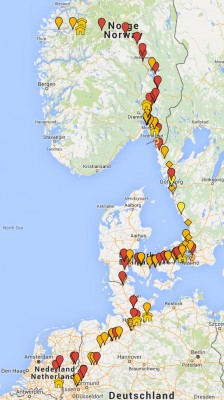 Next to me on the passenger seat I have the complete list of charging stations. For the first part of the journey I can choose 3 different routes: Directly through Germany, via the A50 and A1 (Apeldoorn Hengelo), or via A50 A28 A37 (Meppel en Hoogeveen). I choose the A50 and A1 because for today I have a passenger, who I am going to pick up in Wageningen first.
Next to me on the passenger seat I have the complete list of charging stations. For the first part of the journey I can choose 3 different routes: Directly through Germany, via the A50 and A1 (Apeldoorn Hengelo), or via A50 A28 A37 (Meppel en Hoogeveen). I choose the A50 and A1 because for today I have a passenger, who I am going to pick up in Wageningen first. 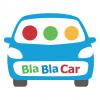 I entered my whole trip in BlaBlaCar, so people can sign up to get a lift. I am traveling alone, have an empty seat available in the car, so why shouldn’t I bring someone who needs to go the same way too?
I entered my whole trip in BlaBlaCar, so people can sign up to get a lift. I am traveling alone, have an empty seat available in the car, so why shouldn’t I bring someone who needs to go the same way too?
It happened that a Chinese student applied, and she had to go in exactly the same direction. 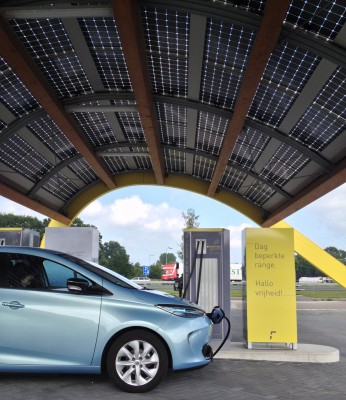 Moreover, this way I will pass some Fastned stations in the Netherlands. At these nice quick chargers with solar panel roof, I am sure the charging will succeed. Abroad with all kinds of strange chargers and cards you never know if it will work.
Moreover, this way I will pass some Fastned stations in the Netherlands. At these nice quick chargers with solar panel roof, I am sure the charging will succeed. Abroad with all kinds of strange chargers and cards you never know if it will work.
So, well begun is half done!
This year on my electric road trip I will mainly use the highway. Driving faster uses more energy, but along the entire route quick or semi-quick chargers can be found, resulting in being able to travel a longer distance per day. Since it is 2000km to my destination, and because in 4 days I am already expected by the Norwegian electric car association (Norsk Elbil forening) in Geiranger, speed is a priority. In previous years the maximum distance I drove was 350km/day. Now I planned approximately 550 km/day, which is 57% more!
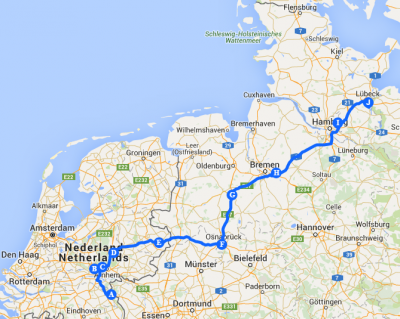 After picking up my passenger, I stop a few times at a Fastned station before we pass the German border. Followed by a quick charger of Ladenetz in Osnabrück, and a semi-quick charger in an Eco park in Emstek. This is where I first use my EWE-card, which seems to work flawlessly. There is even a nice bench where we have lunch together until the car is fully charged. Next we drive to Oyten, to someone who has a real quick charger at home. When we arrive another Zoe is charging there, but the owner immediately unplugs it, when he sees that I am from the Netherlands and hears I am passing through. We even are offered a drink. Okay, it’s only water, but which other charging station offers such a service? The owner even calls a colleague of him in Hamburg, who also has a private quick charger, to announce our next charging stop. That’s great! It turns out that in this area in Germany everybody has such a big electricity connection, allowing a 43kW charger to be connected a home! In the Netherlands with our 3×25 Ampère (17kW) we don’t even come close to that. Once we are finished charging there as well, we can go straight to Lübeck, the destination for today.
After picking up my passenger, I stop a few times at a Fastned station before we pass the German border. Followed by a quick charger of Ladenetz in Osnabrück, and a semi-quick charger in an Eco park in Emstek. This is where I first use my EWE-card, which seems to work flawlessly. There is even a nice bench where we have lunch together until the car is fully charged. Next we drive to Oyten, to someone who has a real quick charger at home. When we arrive another Zoe is charging there, but the owner immediately unplugs it, when he sees that I am from the Netherlands and hears I am passing through. We even are offered a drink. Okay, it’s only water, but which other charging station offers such a service? The owner even calls a colleague of him in Hamburg, who also has a private quick charger, to announce our next charging stop. That’s great! It turns out that in this area in Germany everybody has such a big electricity connection, allowing a 43kW charger to be connected a home! In the Netherlands with our 3×25 Ampère (17kW) we don’t even come close to that. Once we are finished charging there as well, we can go straight to Lübeck, the destination for today.
Lübeck
At 19:00 hours we arrive in Lübeck where I first bring my passenger to her address, and then I drive to Marc where I will stay for the night. I met him on my first trip with my Zoe in Switserland. He showed me around the company Brusa. They make high-efficient power electronics for electric vehicles. Since then we have kept in touch.
He is already waiting for me when I arrive at his home. He has a red CEE 3-phase socket that I can use to charge the Zoe. But first we go to dinner. The organic restaurant that I found on the internet, sadly does not exist anymore, so we go into town and visit an Italian restaurant. Upon returning, it seems my Zoe does not charge very well on the red plug. It takes a lot of effort to get the battery from 40 to 63%. Then the charging stops and an error message is displayed. It is getting late and because the quick charger in Neumünster is now within range, I decide to continue the charging there tomorrow.
25-8-2015 Lübeck – København [477 km]
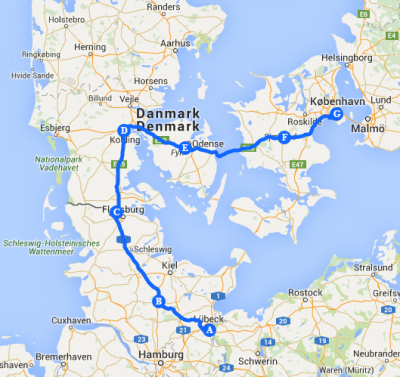 After breakfast and saying goodbye I hit the road towards Neumünster. The trip goes smoothly and I arrive with 17% charge left in the battery. The company has a small quick charge box on the wall with two sockets. It can be configured to 1×43 or 2x22kW. Because nobody else needs to charge, we put it on 43kW. But my Zoe again suffers from lots of charging pauses, so we try lowering the speed to 22kW. This works much better. But I wonder if this is a coincidence, so I put it back to 43kW, which also seems to work fine now. These uncommon charging pauses do occur sometimes since the beginning of my journey, and that concerns me a bit for the rest of the journey.
After breakfast and saying goodbye I hit the road towards Neumünster. The trip goes smoothly and I arrive with 17% charge left in the battery. The company has a small quick charge box on the wall with two sockets. It can be configured to 1×43 or 2x22kW. Because nobody else needs to charge, we put it on 43kW. But my Zoe again suffers from lots of charging pauses, so we try lowering the speed to 22kW. This works much better. But I wonder if this is a coincidence, so I put it back to 43kW, which also seems to work fine now. These uncommon charging pauses do occur sometimes since the beginning of my journey, and that concerns me a bit for the rest of the journey.
From Neumünster to Padborg in Denmark is about 100km. I decide to drive 120km/h where possible. With the given speed and distance it should just work out. With only 2% (!) Battery charge remaining I arrive at the destination. A quick charger from Clever is here, and for backup a semi-quick charger nearby, otherwise I would not have taken the risk arriving with such a low battery. To charge at Clever I ordered well in advance a pre-paid card of 100kWh, which I can upgrade over the internet, if needed.
While charging I connect my special diagnostic device at my Zoe, and I notice the battery temperature has reached 43°C! I have never seen it that high before. The continuous driving on highways and quick charging, add up to the battery temperature. I’m curious what the maximum possible value is.
Kolding
The next stop is in Kolding, where the two chargers on a parking lot both have two sockets. Only one parking place is marked with a small sign to indicate it is reserved for charging an EV, and that is the only free space available. I quickly discover that the charger at that spot is not working, but luckily my charging cable is just long enough to reach the other charger being occupied by fossil cars.
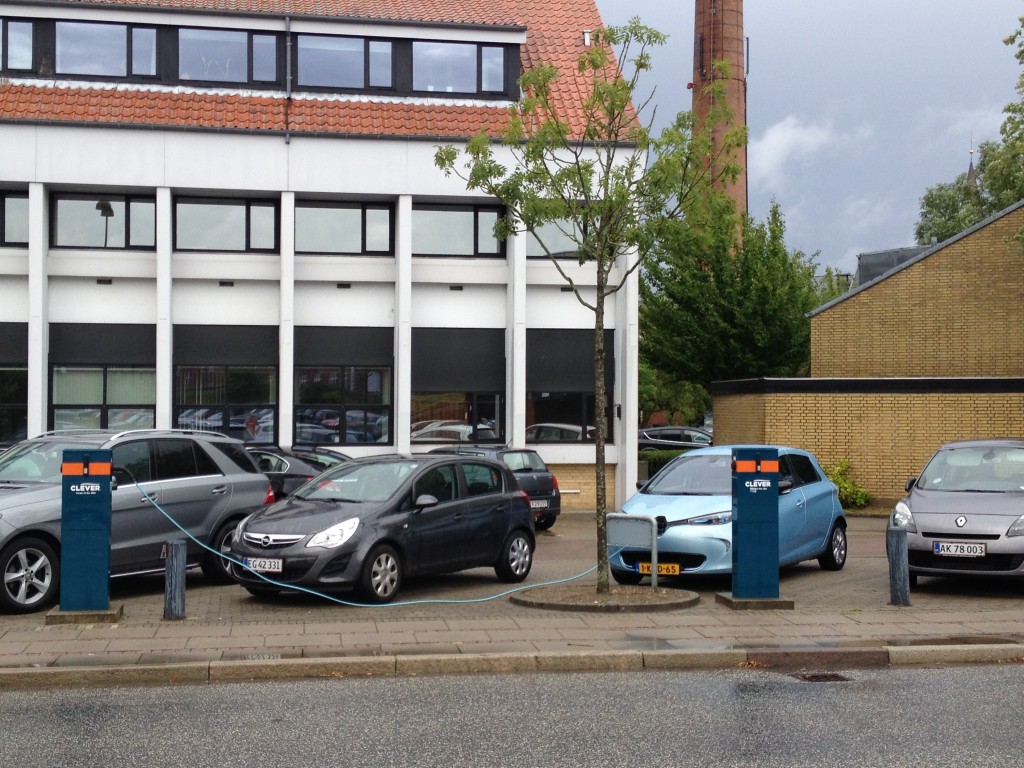
After a stopover in Odense I’m heading towards the first big bridge in Denmark, named the Størebæltbroen. It is 18km long and connects the Danish islands Fyn and Sjælland. It is a great piece of architecture! After crossing it, I pay toll with my Credit card, and find a place where I can take a nice picture of the bridge. Just as I am taking a picture it suddenly starts to rain heavily and a hard wind is blowing! So I take shelter in my Zoe. Fortunately, the storm passes quickly. Now that the sky has cleared you can see the bridge much better too.
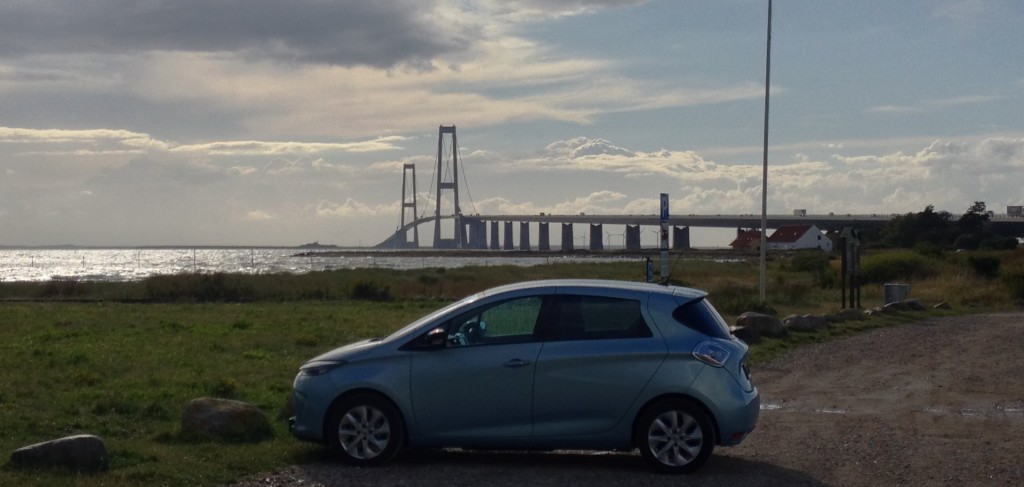
And as a bonus I see a beautiful rainbow on the other side! I manage to capture it with my camera very nicely, with my Zoe exactly in the middle.
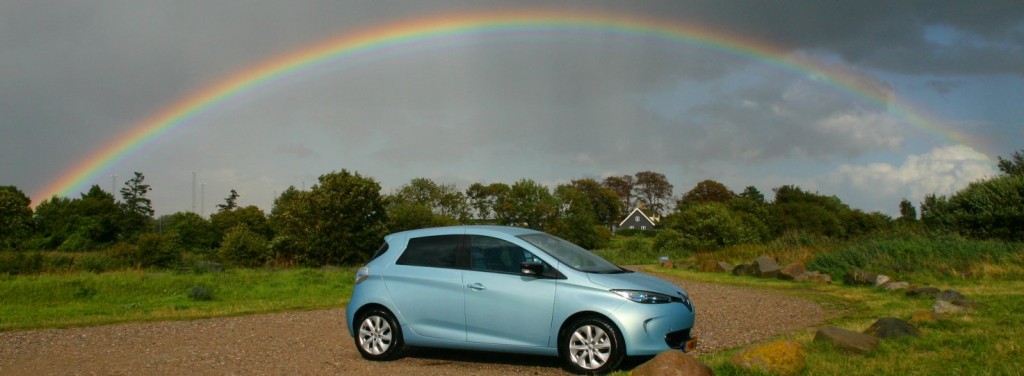
At 19:15 I arrive at the Cabinn Metro Hotel located on the outskirts of København. Directly adjacent in the car park of the shopping center there is a charging point. That is a perfect place to charge my Zoe while having Penne with salmon in an Italian restaurant on the top floor of the shopping center. Very tasty dinner! Afterwards we both go fully satisfied back to the hotel. This made the 2nd day of the journey also totally successful.
26-8-2015 København (via Sweden) to Sarpsborg [535 km]
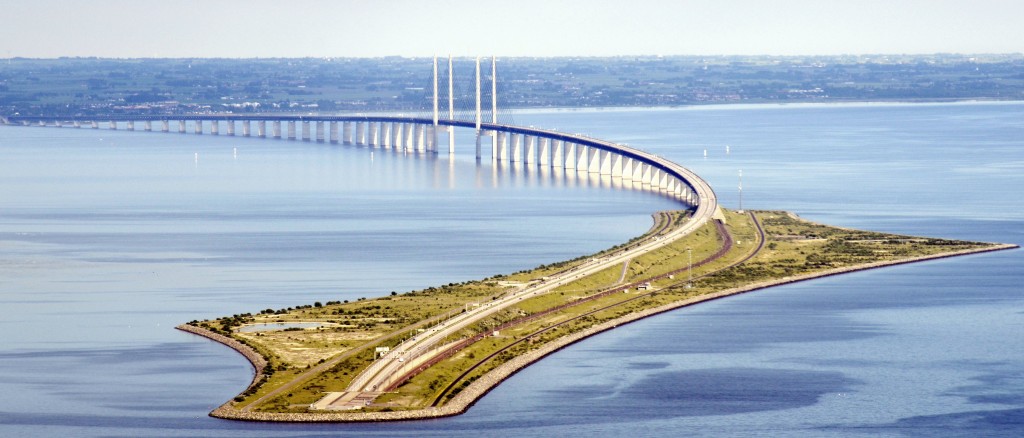
Today the trip begins with the crossing to Sweden, first through a 4km long tunnel and then over the 16km long Oresund Bridge (Danish: Øresundsbroen, Swedish: Öresundsbron). This beautiful bridge, consisting of a double railway track and on top of a four-lane highway, I recognize from the Danish / Swedish television crime series Bron / Broen. This series takes place on and around this bridge. One of the reasons why I did not take any ferry is that I wanted to have a closer look at this very impressive piece of architecture.
Renault ZE dealer
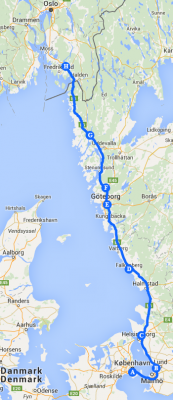 Until now the charging went quite successful, except for some strange frequently occurring charge pauses (of about 15 seconds per occasion). Because I do not trust this completely, I decide to visit a Renault ZE dealer in Helsingborg. But it seems they only sell Zoe’s here, and do not do any maintenance on cars. That is why they do not have a charging station. Nevertheless, the technical guy is very helpful. He even searches in his computer for possible causes, but does not find anything similar and instructs me to go to a dealer in Göteborg about 230km below the road, who might be able to look into it. To get there, I first charge at Ikea near Helsingborg, followed by a stop in Falkenberg. (In the Netherlands we would call this most likely Valkenburg.) But now for the first time, I need some help. It seems the charger can only be activated by means of a Swedish text message. Very “handy” for foreigners, but fortunately the owner of the charger, an energy company, seems to be in the neighborhood, and they are sending over an employee for help. 10 minutes later he arrives. Jens, the ‘Miljöchef’, has a special chip that also activates the charger. Great, that’s settled then. Or isn’t it? It charges very slowly! It seems the charger is only half the speed than indicated on the pole 🙁 . So it is going to be a long stop, but with enough time for an extensive lunch. I grab a meal salad from my electric cooler box, and start eating it on a bench across the charger. A passerby asks me spontaneously where I bought it. I look at him and say drily: “In the Netherlands!” He looks surprised, but I can see disappointment on his face. Too bad for him you cannot buy it here.
Until now the charging went quite successful, except for some strange frequently occurring charge pauses (of about 15 seconds per occasion). Because I do not trust this completely, I decide to visit a Renault ZE dealer in Helsingborg. But it seems they only sell Zoe’s here, and do not do any maintenance on cars. That is why they do not have a charging station. Nevertheless, the technical guy is very helpful. He even searches in his computer for possible causes, but does not find anything similar and instructs me to go to a dealer in Göteborg about 230km below the road, who might be able to look into it. To get there, I first charge at Ikea near Helsingborg, followed by a stop in Falkenberg. (In the Netherlands we would call this most likely Valkenburg.) But now for the first time, I need some help. It seems the charger can only be activated by means of a Swedish text message. Very “handy” for foreigners, but fortunately the owner of the charger, an energy company, seems to be in the neighborhood, and they are sending over an employee for help. 10 minutes later he arrives. Jens, the ‘Miljöchef’, has a special chip that also activates the charger. Great, that’s settled then. Or isn’t it? It charges very slowly! It seems the charger is only half the speed than indicated on the pole 🙁 . So it is going to be a long stop, but with enough time for an extensive lunch. I grab a meal salad from my electric cooler box, and start eating it on a bench across the charger. A passerby asks me spontaneously where I bought it. I look at him and say drily: “In the Netherlands!” He looks surprised, but I can see disappointment on his face. Too bad for him you cannot buy it here.
Finally at half past 4 the battery has gained enough energy to get to Göteborg, about 106km. But at departure suddenly a red light with a wrench symbol appears on the dashboard. It says: “Maintenance needed”. Oh no, would this have something to do with the many charging pauses? The car does drive, and the message does not force me to stop immediately. I press the button to clear the message and then it shows: “Maintenance needed over 30000km or 12 months”. The car has had planned maintenance two months ago, so why does it tell me this now? Anyway, the message is gone, and hopefully it will stay that way.
When I arrive at the Renault ZE dealer in Göteborg, it is already half past 5. I immediately approach a sales person, but unfortunately the technical service has gone home already. He helps me to charge the car, because the public charger from Fortum is out of order. This is my first visit to one of Fortum’s chargers, but the fact that the key of the dealer also cannot bring this charger to life, comforts me that it is only this charging pole, and not my Fortum charge key. In the meantime I make a call to the hotel, to announce that I will probably arrive late. If I will be there before 23:00 they can still show me my room, otherwise they will leave an envelope for me. I also call Renault Route Service about the charging pauses, but they do not have a ready-made solution for it, and as long as the car drives and no fatal error messages occur, they will not take action. They assure me that in case of an emergency, help will be available. That’s a comforting thought.
Fortum-key
The next stops are in Kungälv and Munkedal. The first one is for free, and the second charger proves that my Fortum charge key is valid. That is good to know, because I will need it many times in Norway. It’s already 20:00, and I’m getting hungry. I am at a McDonald’s, but absolutely no fan of their food, so I will make my own dinner. I brought three different kinds of Zonnatura organic meals that can be prepared in a few minutes using hot water. That’s where my 12V cooker will come in handy. While Zoe is charging, I use a little bit of power to prepare my meal “Quinoa with tomato & olive”. Delicious and also very healthy. McDonald’s cannot compete with that 🙂 .
From here I can drive to the Hotel without stopping. Even at the Svinesundbroen between Sweden and Norway I can keep driving, because I registered my license plate number together with my credit card with Autopass, so the toll is automatically debited. Within three days I reached Norway already without ferries!
At 22:00 I arrive at the Hostel Vandrerhjem Tuneheimen in Sarpsborg, well before closing time of the reception.
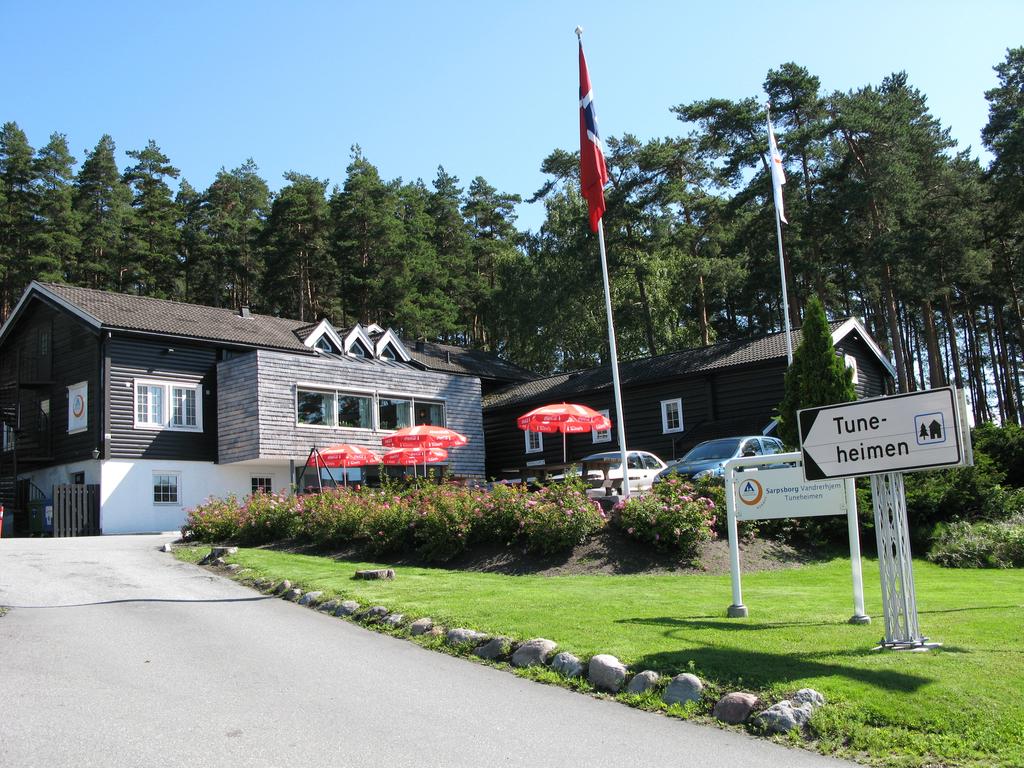
(Battery temperature rose today from 25 to 36°C.)
27-8-2015 Sarpsborg
On this rainy day I visit the nearby Science Museum and at the same time charge the car, which is free for visitors. Because the most interactive devices are focused on children, I find the museum a bit disappointing. Also a show is presented this way and moreover entirely in Norwegian. Therefore after I went to lunch, I call it a day. I disconnect Zoe from the charger and with a full battery I return to the hotel. Meanwhile the rain has stopped and I decide to go for a nice jog. After three days of driving I can use some exercise myself. Behind the hotel is a beautiful lake, and I guess it is 10km around it. Perfect! I get a hint from a German girl staying at the hotel, telling me where the trail begins. In the beginning it is a perfect trail for jogging indeed with a nice view over the lake, but after a few kilometers it turns into an unpaved path. It is getting wetter and wetter. I try to keep my feet dry, but at some point I cannot avoid it anymore. My feet drown into the marshy grass and moss. I wring my socks, but moments later the water runs into my shoes again. So I continue with wet feet. When I lose the trail suddenly a playful dog comes towards me, also dripping wet. I look around me and ten meters below I see a lady walking who obviously is following the right path. So I go that way too, and we start talking. She is very friendly and seems to be a resident of the local town, who walks her dog between working hours. She tells me there was a lot of rain here the last few days, which explains the very swampy conditions. I get a detailed explanation of how the path continues around the lake. I thank her cordially, and proceed through the swampy path. Further on I have to jump over a stream, but there is so much water in it, that it is much too wide to jump over. On the other hand, I’m already wet anyway… The path on the other side of the lake is a bit better, but also very wet. Back at the hotel I put my shoes and socks to dry, take a shower, and look for a nearby restaurant for dinner on the internet.  I’m going to walk into town, and end up at restaurant Pizzanini, where the nice Norwegian waitress takes good care of me. I do not take a dessert after the main dish, because tonight is the big moment to consume my home-grown, deliciously scenting pineapple. At the hostel there is a small kitchen for guests, and there I sit down at the table. I carefully cut it, so that nothing is lost. Then I take a bite out of the first slice. It is really the best pineapple I’ve ever eaten. It took no less than five years to grow, but that makes it extra special.
I’m going to walk into town, and end up at restaurant Pizzanini, where the nice Norwegian waitress takes good care of me. I do not take a dessert after the main dish, because tonight is the big moment to consume my home-grown, deliciously scenting pineapple. At the hostel there is a small kitchen for guests, and there I sit down at the table. I carefully cut it, so that nothing is lost. Then I take a bite out of the first slice. It is really the best pineapple I’ve ever eaten. It took no less than five years to grow, but that makes it extra special.
While I am taking pictures of it, someone enters the room. I see her looking, and I explain to her that I grew this pineapple myself in the Netherlands. That immediately aroused her interest, and she also likes to try this. So I explain to her how you can do this the best possible way. After the last piece is gone, I take the crown with me, because I could grow a new pineapple plant with it.
28-8-2015 Sarpsborg – Geiranger [540 km]
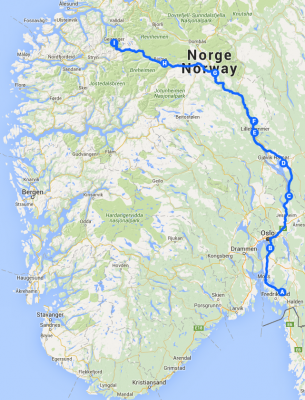 After the first stop in Kolbotn, I arrive at gasstation Statoil in Minnesund. This is the first gas station I see where the quick chargers are arranged the same way as the fossil fuel pumps. Even the payment method is the same. The AC plug is available, and at the DC a Kia Soal EV is charging. Inside are two ladies, and they ask me if I am also going to the EV festival in Geiranger. “Certainly!”, I say enthusiastically, and a nice conversation follows. They are surprised I came all the way from the Netherlands, and I explain how my journey has gone so far. Their Kia has finished charging, so they go on their way to the next charge stop. I still have to charge, but likely we will meet again there. The charging goes smoothly, and I am even allowed to take free coffee or tea.
After the first stop in Kolbotn, I arrive at gasstation Statoil in Minnesund. This is the first gas station I see where the quick chargers are arranged the same way as the fossil fuel pumps. Even the payment method is the same. The AC plug is available, and at the DC a Kia Soal EV is charging. Inside are two ladies, and they ask me if I am also going to the EV festival in Geiranger. “Certainly!”, I say enthusiastically, and a nice conversation follows. They are surprised I came all the way from the Netherlands, and I explain how my journey has gone so far. Their Kia has finished charging, so they go on their way to the next charge stop. I still have to charge, but likely we will meet again there. The charging goes smoothly, and I am even allowed to take free coffee or tea.
Øyer
The next charging point on my list, is already 53 km further in Stange, but because the E6 that I am following, turns into a two way road, where most of the time 80 km/h is allowed, I start calculating again. Due to the lower speed the range increases, I can skip Stange, and drive all the way to Øyer at once. That will be an extra 75 km, but with this lower speed that should not be a problem. Using this tactic I might catch up with the two ladies, and arrive in Geiranger earlier 🙂 .
After a long drive the navigation reports that my destination has been reached. I look around, but I see no charging station. Sometimes the charging point is just around a corner, so I do not give up immediately. I look everywhere, but it is not there. Then I open the ChargeMap App, but it also shows no charging point nearby. Hm… strange. I zoom out on the map, and discover that the charging point is about 12 km back. So I already passed it! And the Low-battery indicator is already on with just 12 km range left. I would have expected to have a little more backup, but that explains it. It is not possible to continue my route, because the next charging point is only after 40 km. So I have to go back. Luckily the way back is a little downhill, so it should not be a problem. It is a waste of time, but I have no choice. On my way back I try to pay attention where to go. De remaining range drops further, and Zoe alerts me of the fact that I really need to charge. Yes, I know, I am on my way to the nearest charger! At one point I doubt taking the exit, but to look on a small map while driving is hard, so I drive by. Then looking at the App again, I see I should have taken the exit. But I cannot make a U-turn here, because there is a barrier in the middle of the road. And to make it worse, the message “Limited performance” is displayed. Oops, how far will it be until the next exit? I pull over at the roadside, to check the map again. The next exit is further away than I thought, but I have no choice than to try to reach it. When driving off I notice the power of my Zoe is really limited now. Therefore I can only drive slowly, and a queue is quickly piling up behind me. Slowly I start to realize that it is inevitable I will not make it to the charging point anymore, and the only option remaining is to let the car roll into the next emergency parking. When I arrive, I park my Zoe and for the first time I will have to call Renault Assistance asking them to tow me to the nearest charging point. It is 15:00 and I dial the number.
I: “Good afternoon. I am stranded along the E6 in Norway close to Lillehammer with an empty battery. Could you send help?”
After a moment of silence on the other end of the line, the employee of Renault Netherlands says: “In Norway????”
I: “Yes. Why?”
Renault: “Ehm, well. We will find out which Road Assistance company can do it, and then we will call you back.”
While waiting I figure out why the navigation took me 12 km past the charging point. It seems that within the municipality Øyer there are two villages with the same street name! And (of course) the navigation chose the wrong one. If I enter Grandrudmoen as the city, the destination is correct! So if the address of the charging station would have been correct, I would have arrived with about 24 km of range left. That corresponds much better with the estimation I made earlier. But now my car is pointing backwards in the direction of Lillehammer and I’m waiting for the tow truck… Anyway, half an hour later they call me with the message that the assistance will be there around 16:00. So I will have to wait another half an hour. About 10 meters off the road I find lots of raspberries, blueberries and cranberries. Waiting is so annoying . My fingers are all red from the berries when I go back to the car at almost 4 o’clock. In the distance I see a big yellow truck coming. Great, he’s right on time. With her last burst of energy Zoe can drive on the tow truck of the NAF (Norges Automobil-Forbund).
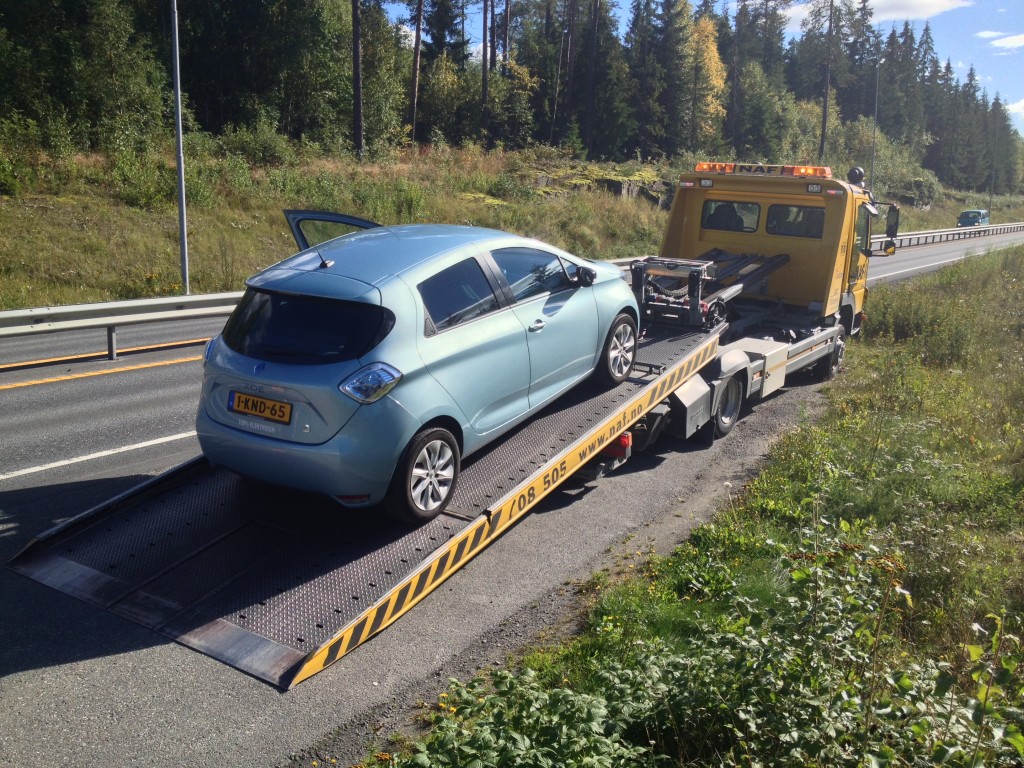
They will bring me to Lillehammer, about 10 km back. I would prefer that they would take me to Grandrudmoen, but then I have to pay extra. So I say, “If only they have an AC quick charger in Lillehammer”. When we get there, it seems the quick charger only delivers DC power, and that is incompatible with the Zoe. But the men of the NAF don’t give up yet, because they know there is another quick charging station in Lillehammer. This one does have AC power. They unload my Zoe, and wait patiently until it is certain the charging goes well. I thank them for their help, add the charging point which is new for me on the map, and after half an hour of charging I am back on the road again. All in all I lost more than 2 hours by this error in the address of the charging station. I realize that I definitely will not be in time for the evening buffet. But for cases like this, I wrote down the phone number of the hotel. I call it, and they will put a meal for me aside.
Although I’m late, I want to know exactly where the charging point is that I missed, because I might need it on my way back.
At the last charging point before I reach the hotel, it becomes a bit exciting again. To activate this, I have to use the GoCharge App on my phone for the first time. Dusk is falling, and I really do not want to call for help again. But the slider opens immediately when I activate the charger with the App. 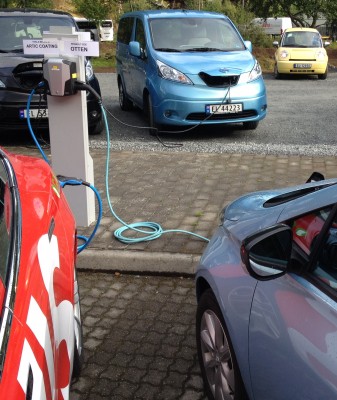 Despite some charging pauses, that I have gotten used to, all goes well. And after charging for half an hour I start off in the dark to go to Geiranger, the destination. The last part of the trip leads over a 1038m high mountain pass, where the outside temperature has dropped to 5°C. Then a winding road descends over 1000m until I arrive at the Hotel. This recharges the battery for a large part, a nice effect I experienced earlier in Switzerland.
Despite some charging pauses, that I have gotten used to, all goes well. And after charging for half an hour I start off in the dark to go to Geiranger, the destination. The last part of the trip leads over a 1038m high mountain pass, where the outside temperature has dropped to 5°C. Then a winding road descends over 1000m until I arrive at the Hotel. This recharges the battery for a large part, a nice effect I experienced earlier in Switzerland.
After reception at the Hotel, it appears that I have my own charging pole!
A new charging park opposite the hotel has up to 30 (!) charging points which will be opened officially tomorrow. And especially for this meeting the Norwegian electric car association has also added 20 temporary charging points, giving each participant its own charging pole. Very well organized!
29-8-2015 Geiranger ‘Elbil forening’
After a very extensive breakfast buffet, the opening speech is held in a large hall of the hotel. Everything is in Norwegian, but I do recognize some words. Then the General Secretary suddenly speaks in English. It appears that I am the subject! Since I’ve come all the way from the Netherlands to Norway, I receive a special welcome, and even applause! Such a warm reception.
Next the official opening of the new charging park takes place and subsequently all 100% electric cars drive in convoy to Dallsnibba, the highest road with a spectacular view over the fjord. It is a 1500 meter climb, but all cars make it to the top without any problems. After a break we go back to the Hotel together. During this trip many photos are taken and professional video is recorded, including using a drone.
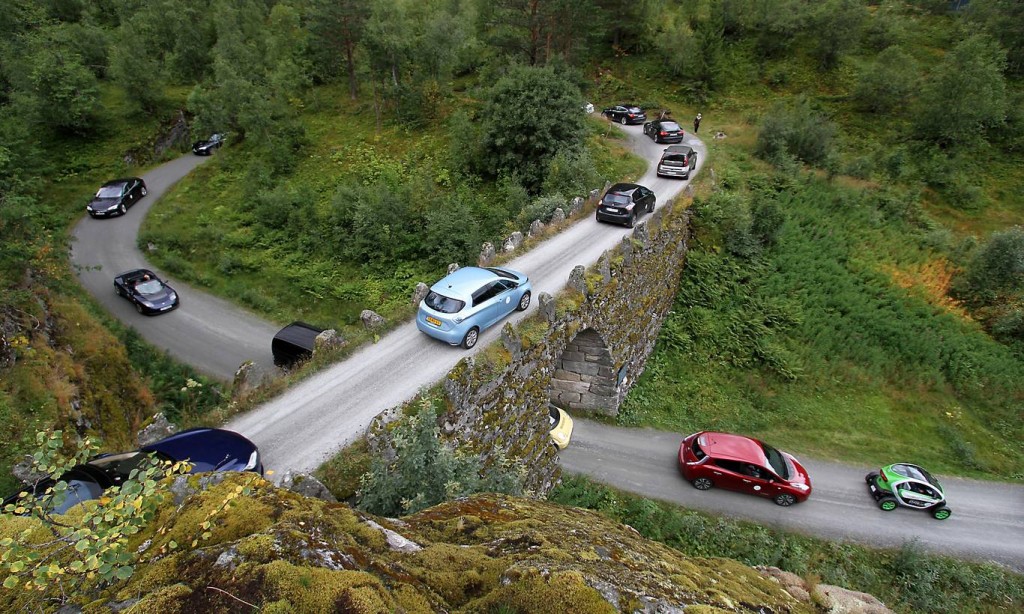 (Wikipedia: Knuten)
(Wikipedia: Knuten)
At the top the battery level of my Zoe was approximately 60%, and when returning 70% again. The trip was 40km. Because the battery has cooled down during the night, the charging speed of the battery is slightly reduced, which resulted in less energy being able to recover during the descent. Nevertheless, the consumption of this eRally was only 140 Wh/km (including charge losses). With this consumption a range of 180km would be possible.
The rest of the afternoon there is no program, but because they would like to have some more pictures, we go up the mountain again with a select group of cars, and I may drive a Nissan Leaf. Cool, because I haven’t driven in such a car before. The car is a little bit bigger than a Zoe, but the steering wheel isn’t adjustable axially, making the position behind the wheel for me with my height of 1,95m not perfect. Besides the normal D (drive), the gear lever also has a mountain gear. Well, it is not really a gear, the difference is that during downhill driving more energy is automatically regained by the electronics, when releasing the throttle. One drawback is the hand brake, which has to be operated by your left foot. Besides, in the Leaf you need the hand brake more often than in a Zoe, because the Zoe automatically holds the brake for you when standing on a slope while moving your foot from the brake to the throttle.
After a number of photos they thank us, and then we drive down, back to the hotel. Upon returning the Communications Advisor / Web Editor of elbil.no then asks me for an interview, because they would like to write an article about me and my enthusiasm for electric driving. I agree. He takes a few pictures of my Zoe and me, and we do the interview in the car. (This is the result.)
At the end of the afternoon there is a presentation of the oldest electric car in Norway.
After an extensive and delicious dinner buffet, a preview of the video recordings of this afternoon is shown in the conference room. They last only 2 minutes, but it looks very nice and professional, resulting in a big applause. Watch the final version here: eRally Geiranger 2015: Taking electric vehicles out of town!
30-8-2015 Geiranger: Farewell elbil forening + 1st mountain hike
At saying goodbye Rune Hole, Marketing Manager of The Norwegian Electric Vehicle Association, tells me he left an envelope for me at the reception desk, containing a Key of the Norwegian association as a keepsake, plus a Norwegian parking disc. Almost all public car parks in Norway are free for electric cars, but there could be a time limit, and that is where the disc comes in handy. For these items, and also the extra days he booked for me at a discount in the luxury hotel, I thank him cordially!
In the afternoon I go out hiking with my boots for the first time. I start walking from the hotel along the fjord and follow the path a bit further up. Along the way on a bench with a beautiful view of the fjord, I meet a Chinese girl. She is also hiking alone.
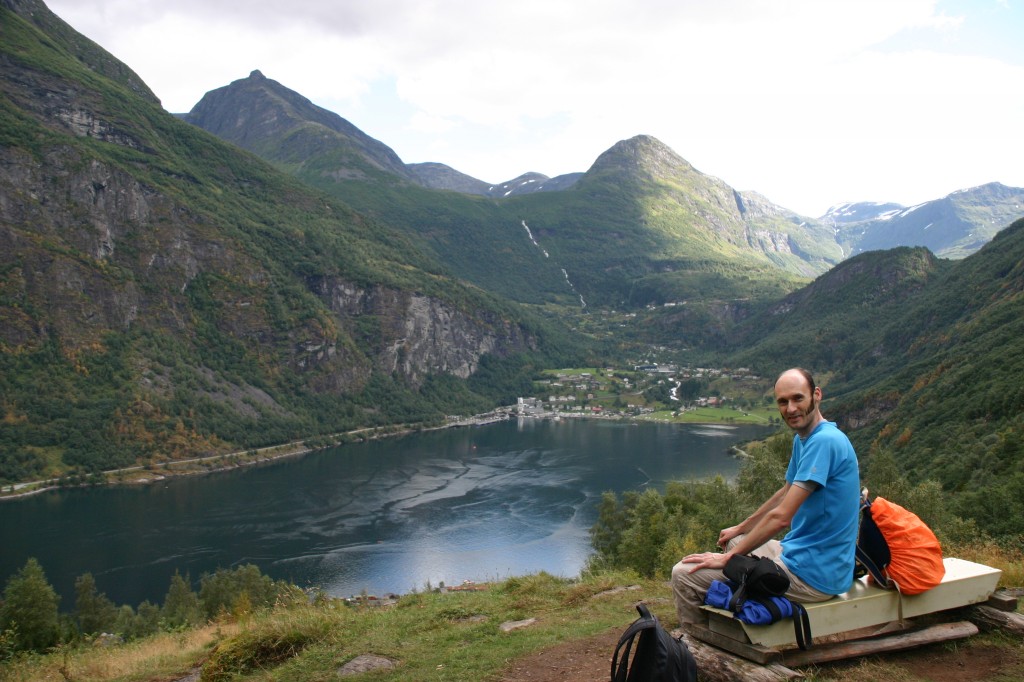
We take some pictures of each other with the view, grab a bite to eat, and continue our own path. Further along the path the stones become very slippery because of some drizzle. On arrival at Homlongsætra (a 550m climb), I therefore decide not to continue any further. It is enough for a first hike.
31-8-2015 Geiranger: Mountaintop Geitfonnegga
Time flies, and at the last day in Geiranger, I still want to climb a little mountain top. I drive the car to the north side of the fjord to 638m altitude. From there on I will go to the Geitfonnega 1536m. While putting on my hiking boots and have a look at the map, another car arrives, and a sporty-looking girl gets out. We say hello and start a conversation. She is from Sweden, and works here during the season. She recognizes me from the other day when I was at the Geiranger Sjokolade shop. Indeed! In this sporty outfit I did not recognize her immediately. I tell her that I joined the elbil meeting last weekend. She responds enthusiastically by saying: “There was even a guy who drove all the way from the Netherlands to here!” I look at her smiling and say: “Well, you are speaking to him now 🙂 “. It seems the Geiranger Sjokolade car that also joined, belongs to her boss. And that’s how the news travels fast in the village.
The trip to the top has stunning views of the fjord.
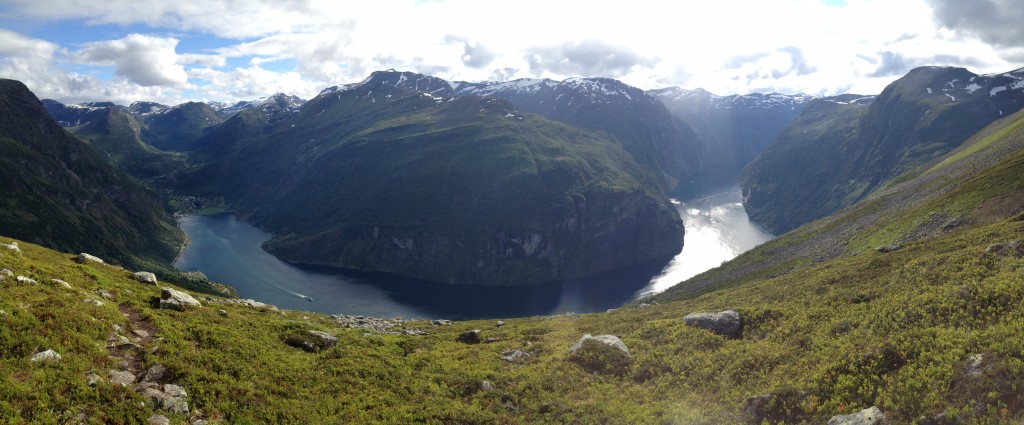
The last part involves a bit of scrambling, but I like that. Now I understand why only this path was marked in black on the signs. It shows the level of difficulty. But that doesn’t stop me, and at 2 o’clock I’m on the top.
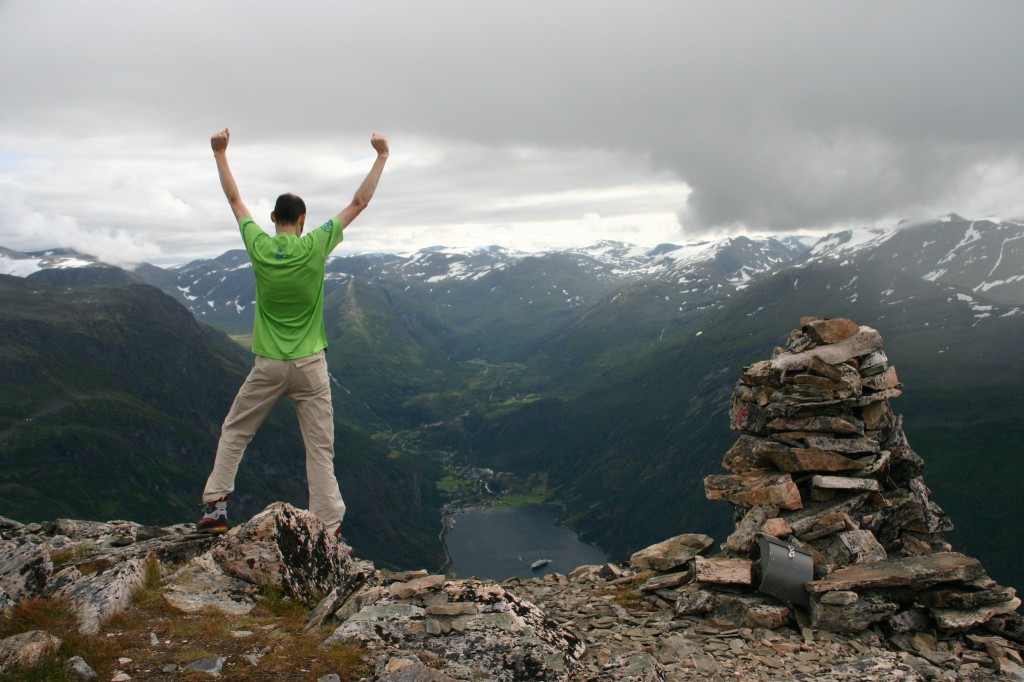
On the way back I use a small snowfield to slide downwards. That goes a lot faster, and is fun too.
On returning I plug my car into the charging station at the Hotel, to make sure it is completely full for the next day. Before dinner I still have time to go swimming in the hotel pool. I can walk from my room down the hallway wearing swimsuit and bathrobe to the pool. That is convenient! It is a beautiful indoor and outdoor pool with massage jets and bubbles.
1-9-2015 Geiranger – Hjelle [48 km]
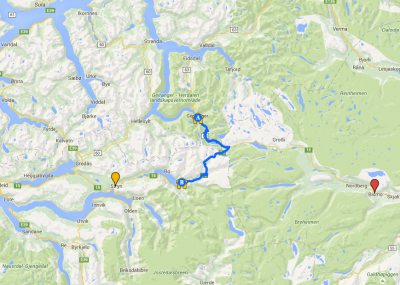 The drive to Hjelle is only 48km, but I pass the 1000 meter high mountain pass again, for the 3rd time. The Hjelle Hotel is located right on the large freshwater lake, but you can only notice that when you are nearby. The environment is really as beautiful as on the pictures.
The drive to Hjelle is only 48km, but I pass the 1000 meter high mountain pass again, for the 3rd time. The Hjelle Hotel is located right on the large freshwater lake, but you can only notice that when you are nearby. The environment is really as beautiful as on the pictures. 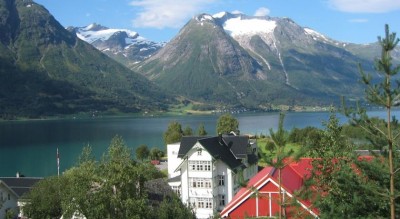 The color of the meltwater is green-blue, and with no wind you see a wonderful reflection of the snowy mountains in it. What more can I ask for!? Well, a charging point would be nice for the return journey. The owner shows me an outlet at the outside of the hotel. I have my doubts whether it will work for the Zoe, because the old Norwegian IT-network is probably present here, which is not suitable for the Zoe. My guess is confirmed quickly. Good thing I got a hint from someone at the EV-festival in Geiranger, that a chargepoint is present in the village Stryn, situated 27km away from here. This point was unknown to me, but the Norwegian App (LadeNå!) does mention it as a 22kW charger. So I trust that will work. All charging stations in Norway of 11kW or more are connected to the newer TN-network (having 400V), which is similar to most of the European power grid.
The color of the meltwater is green-blue, and with no wind you see a wonderful reflection of the snowy mountains in it. What more can I ask for!? Well, a charging point would be nice for the return journey. The owner shows me an outlet at the outside of the hotel. I have my doubts whether it will work for the Zoe, because the old Norwegian IT-network is probably present here, which is not suitable for the Zoe. My guess is confirmed quickly. Good thing I got a hint from someone at the EV-festival in Geiranger, that a chargepoint is present in the village Stryn, situated 27km away from here. This point was unknown to me, but the Norwegian App (LadeNå!) does mention it as a 22kW charger. So I trust that will work. All charging stations in Norway of 11kW or more are connected to the newer TN-network (having 400V), which is similar to most of the European power grid.
It’s still early in the afternoon, so I go for a hike to Segestad proposed by the hotel owner.
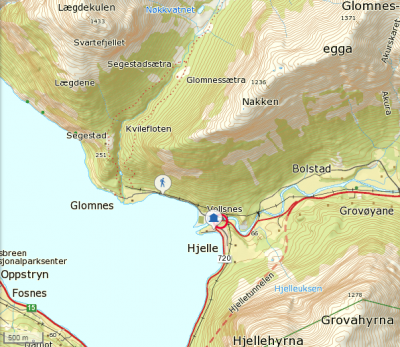 The trail turns out to be more than beautiful. The path passes between immense round polished rocks, over which in the early days large glaciers have scraped. The trees all seem ancient, and are formed by years of hardship. That, along with the view of the lake, and the traces and scents of wild animals, make this area like a beautiful fairy tale and give it a mystical atmosphere.
The trail turns out to be more than beautiful. The path passes between immense round polished rocks, over which in the early days large glaciers have scraped. The trees all seem ancient, and are formed by years of hardship. That, along with the view of the lake, and the traces and scents of wild animals, make this area like a beautiful fairy tale and give it a mystical atmosphere.
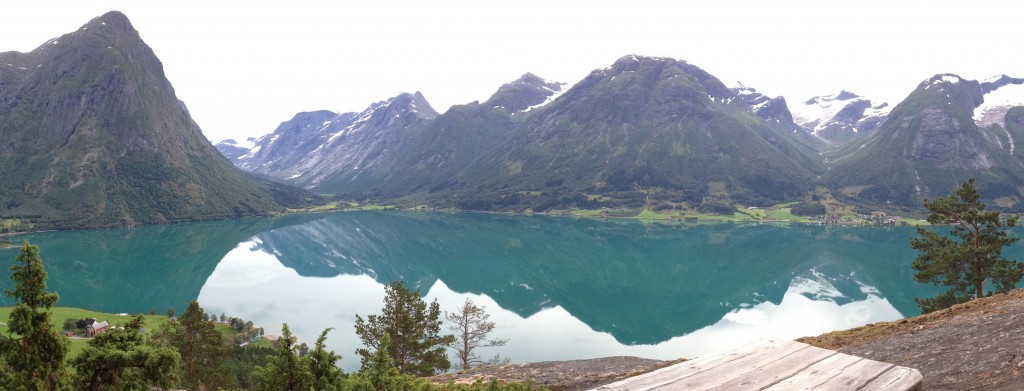
In the evening during a delicious dinner in the hotel I am still enjoying this special hike. The background music has similarities with Enya songs, which fits with the atmosphere of this environment perfectly.
2-9-2015 Hjelle: Erdalen
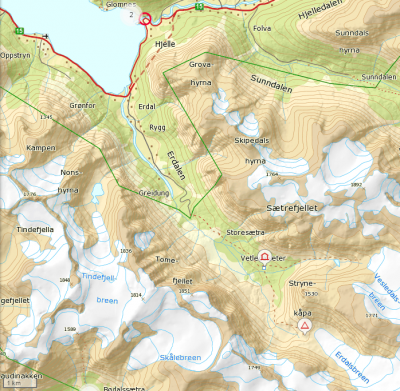 The second hike the hotel owner suggested was towards Erdalen. I drive a short distance with the car into the side valley and park at the last location before you have to pay toll. This is also the place where the nature trail starts. It is an ancient trail running over the glacier towards the south. Again a nice hiking trip and on the way back showing this beautiful view of the lake ‘Oppstrynsvatnet’, where the hotel is located.
The second hike the hotel owner suggested was towards Erdalen. I drive a short distance with the car into the side valley and park at the last location before you have to pay toll. This is also the place where the nature trail starts. It is an ancient trail running over the glacier towards the south. Again a nice hiking trip and on the way back showing this beautiful view of the lake ‘Oppstrynsvatnet’, where the hotel is located.
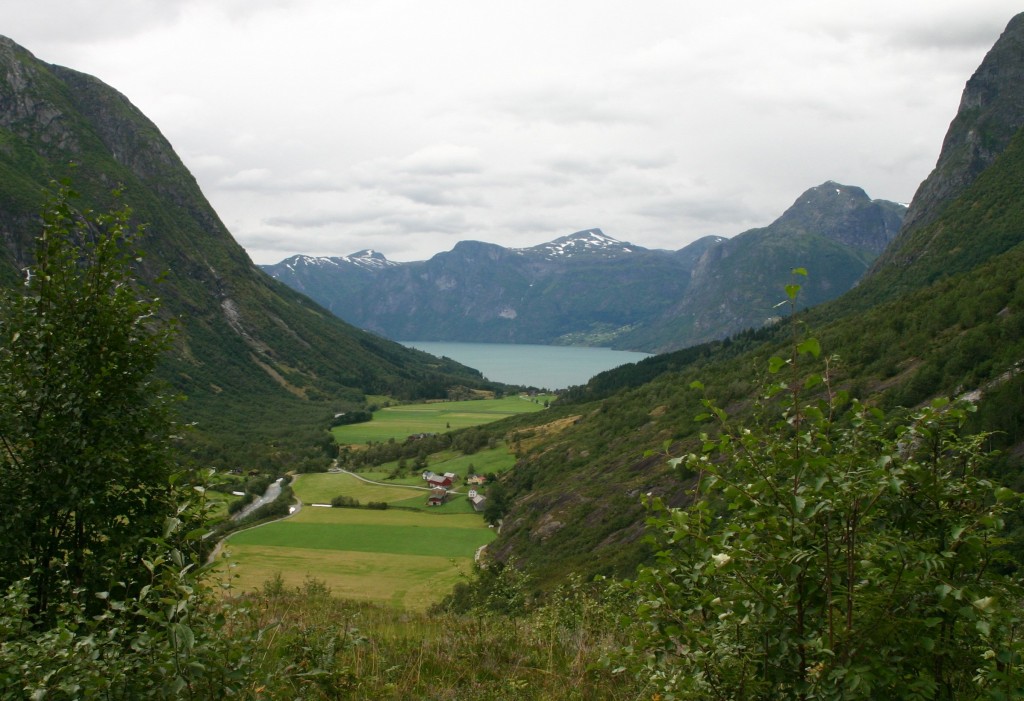
3-9-2015 Hjelle: Sunndalen
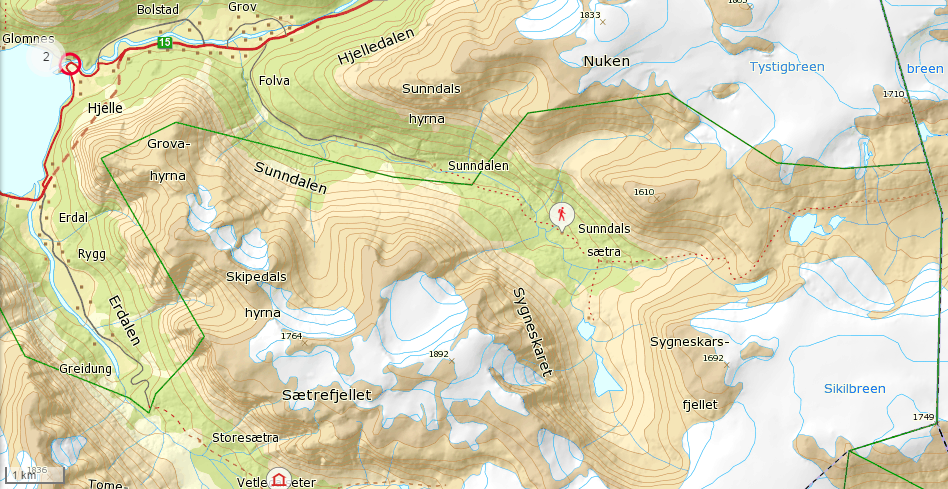
Tomorrow rain is predicted, so today is the last day to enjoy this environment. I got a hint from a Dutch couple that the lakes above Sunndal are very nice, moreover there is a beautiful waterfall along the path. This time I take the toll road with the car, because otherwise it is a long walk on a dull wide road. I’m more of a person who likes exciting narrow trails, and they start at the end of this road. The toll road is narrow and unpaved, but no other vehicles come across and there are no other cars at the parking lot, so it will be a quiet day.
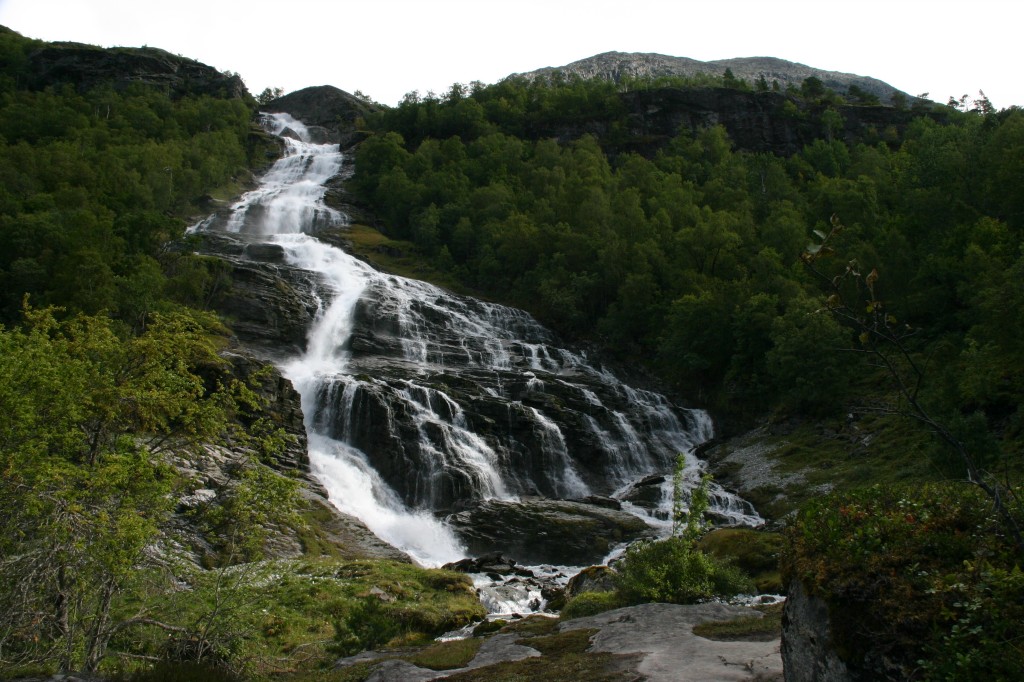
At the rushing waterfall I take the first break in the sun to eat something. Then I proceed to a junction, where I go right. Originally I had planned to go left, but both sides have little lakes, so it does not really matter. It is new to me both. The first lake I run into has a wonderful azure blue color. The water comes straight from a glacier, so it’s not exactly great for swimming. Besides, I did not bring my swim shoes for protection against the sharp stones.
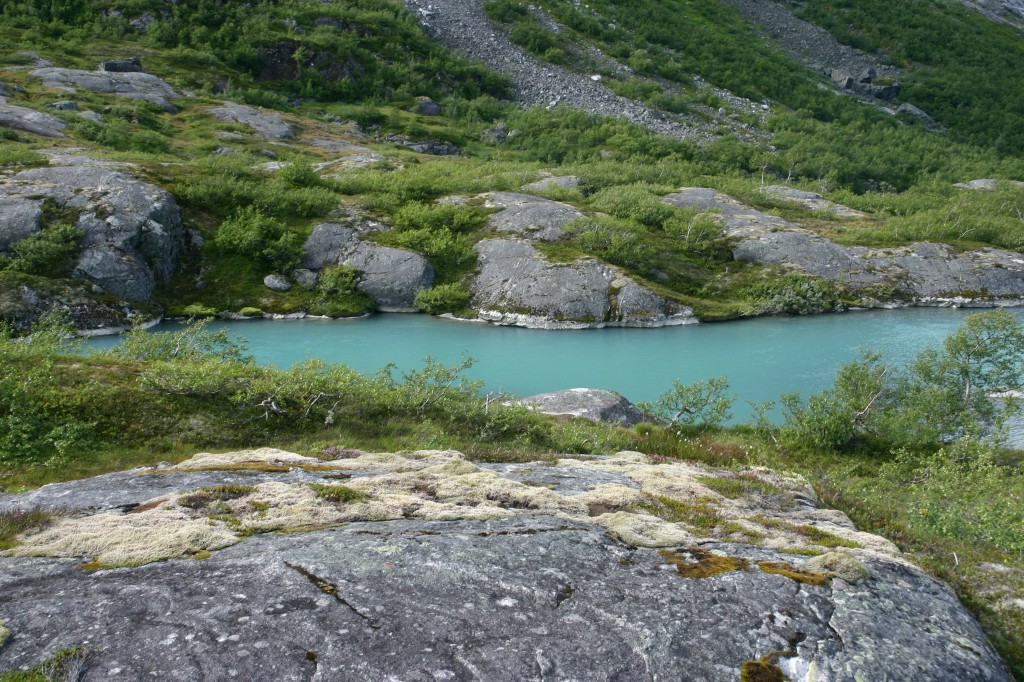
When the path ends at a deserted house, I continue further through bushes and over large boulders along the larger lake to take a break there. From here you can see the glacier clearly, but it is too far to climb all the way to it, especially because there is not path at all. Moreover, I already walked quite a distance, and I also have to go back.
On returning it seems I have walked 19km, and for mountain trails with elevations that is quite a lot.
In the evening I see I received an email from a journalist from Oslo who also likes to write an article about my journey from the Netherlands to Geiranger. He is from www.tu.no a Norwegian Technology magazine. One of the goals of this trip was to show that a long journey with an electric car is very well possible, so I give him a number of possibilities for answering his questions. One is that we meet in Oslo, because I will be there after 3 days. But we do it by email. (See here the final article in Norwegian: hier)
4-9-2015 Hjelle: Stryn
Today it’s cloudy, and the forecast is a little rain. But I go shopping in Stryn, so that’s no problem. I got a hint that a good outdoor shop, called “Skogstad”, is in this City. But first I’m going to look for the charging point, because tomorrow I want Zoe to be fully charged before I start the return journey. It appears to be not hard to find, and after I connect the cable to one of the wallboxes, the charging begins automatically. So it is free again. I add the point to Chargemap and head into town. I buy a nice jacket suitable for all kinds of (Norwegian) weather, and upon returning at the car I see the charging has stopped at 96%. Strange, but by opening the door of the car, the charging continues. I put my purchases in the back, and go to look for a place to have lunch. I enter “Stryn Vertshus”, which means Inn. I order a warm ciabatta sandwich with a cup of tea made with loose tea of good quality. Outside it is pouring with rain. When the rain stops, I find a nice little shop with all kinds of organic food. I buy a few nice things, and go back to the car. The battery is now at 99%, but the fault indicator is on with the message “Battery charging not possible!”. The cause is unknown, and during the ride back to the hotel the indicator stays on. Not a very comforting idea, given the fact that I’m still more than 2000km away from home. But fortunately the indicator turns off, after the car has been locked for a little while, which resets some things. So I assume it was caused by the charger. Anyway, Zoe is now sufficiently charged for leaving this valley tomorrow.
In the evening at the hotel’s restaurant I choose trout as main dish. It was caught by the owner himself! I do have to fillet it myself, but it tastes really deliciously! It is a true feast.
5-9-2015 Hjelle – Oslo [460 km]
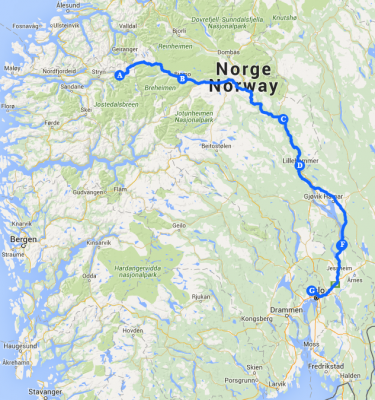 For the first part of the journey out of this valley, I choose a different route that eventually brings me to the same place. It is a somewhat narrower road, which turns out to be unpaved after the mountain pass. Furthermore the temperature at that point is just above freezing, and about 100 meter higher, fresh snow has fallen. And there I am, driving on my summer tires… But on the other hand, the view is spectacular again!
For the first part of the journey out of this valley, I choose a different route that eventually brings me to the same place. It is a somewhat narrower road, which turns out to be unpaved after the mountain pass. Furthermore the temperature at that point is just above freezing, and about 100 meter higher, fresh snow has fallen. And there I am, driving on my summer tires… But on the other hand, the view is spectacular again!
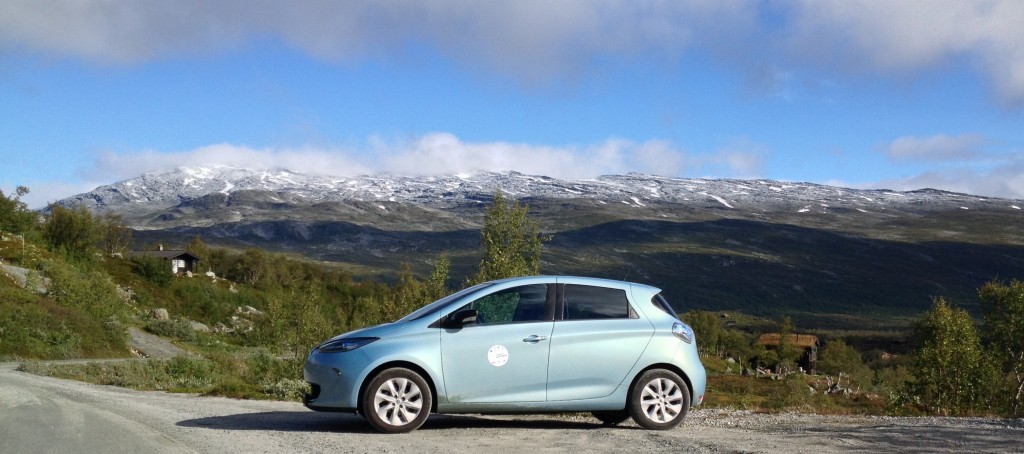
The first stop is in Bismo (Skjåk), the same place that I used on the outward trip. Once there, it appears my cell phone does not have a network connection anymore, but I need that to start the charging! On the charging pole the text says: “In case of problems with charging, call this number”. Ehm…
In the adjacent shop, I explain the situation, and I may use their cell phone to make a call. Strangely enough, this phone has no problem connecting. I ask the lady on the phone if she can remotely activate the charge pole. After a little while she asks: “Does the slider open now?” Ehm, to check that, I will have to go outside with their cell phone. I am allowed to do so, and eventually we got the car charging. The question remains, if the plug of my cable will automatically unlock when I stop the charging. If not so, then I will have to call back again. This does not appear to be necessary.
Just when I am about to leave, a Nissan Leaf is arriving. The driver looks at me curiously. I salute, and he approaches me. Despite his Norwegian license plate he speaks Dutch fluently. Originally that is where he came from, but now he lives here in Norway. He had read in the newspaper about a Dutchman who had come in his Zoe to the EV-festival in Geiranger. The news travels fast, and now he even meets me! Soon I can start signing autographs 😉 Well, my visit seems to have made a big impression, but then again, that was my intention secretly.
The next stop is in Otta. Here I do not need my phone, because this charger can be activated with the Fortum key. That is, normally that would be possible. Now the message “Emergency stop” is displayed, and no matter what I do, this charger K18 does not respond at all. Fortum’s phone number is on the pole. But my phone still has no network. Fortunately, I may borrow a phone from two German girls who are waiting on a bench. The lady from Fortum explains that I must press and hold the red emergency button for 10 seconds to reset things. Sadly, that doesn’t work, and furthermore she doesn’t know what else to do. Someone from the technical service will have to come over. Aren’t they already on their way? Apparently not, and I will not wait for them. I am still able to drive to the next charger in Ringebu. This one I have to activate with the App again, but still no network is available! What’s going on? An adjacent restaurant offers a free Wi-Fi solution. But when charging is finished, my cable is stuck in the pole. This isn’t my lucky day! I’ve heard of these situations before, and now it’s my turn. One thing is for sure, I will not leave this place without my cable! If necessary I will pull this device out of the ground, to get my cable! I try everything to disconnect it, but nothing works. Finally, I discover this charger also has a red emergency button. I find this a case of emergency, so I press it. Surely enough, it works! I grab my cable and go.
The known charger at the McDonald’s in Lillehammer is at a nice distance for the next stop. Here no hassle to activate it, because this pole provides free power. Just plug it in and charge quickly. Perfect!
Just one more stop in Minnesund, and I am able to drive to the hotel in Oslo. I have to take into account a 300 meter climb at the end of the trip, so I will keep a bit more in reserve. At this quick charger of Statoil you an easily pay upfront at the gas station for a quarter or half an hour charging. But the charging process starts, and stops, and starts, and stops again, until it stops completely. They do a reset, and try it again, but it continues to falter. On the way there it went perfectly. Now it seems the charging pauses of my Zoe put a spanner in the works. After several attempts, free tea and sandwiches, the nice employee even offers me my money back. The service is perfect, but the charging could be better. 5 minutes away there is another fast charger at the Kiwi (supermarket). There also charging pauses occur, but eventually (from 45%) the charging process continues normally.
In Oslo the last part of the trip indeed goes uphill, and close to the hotel, the low battery indicator turns on. Just a few more blocks and then, I cannot continue because of a road construction. There is no detour sign, so I have no idea which way to go. I cannot allow myself to get lost now, because I cannot drive long distances anymore. The build-in navigation of the Zoe can help. I zoom out, and choose a road around the obstacle. After a few junctions the navigation points to the right way again. Now I only have to find the entrance, because in the dark it is hard to see. Eventually with a remaining battery level of 13% I park at the reception of Hotel Voksenåsen. Although my phone had no network connection during the whole trip, I ran into a defective charger, and I had to make several detours, I still reached my destination. And when the cash machine at the hotel cannot make a connection to register my Credit card, it doesn’t surprise me. It only makes me laugh. “Probably the network is down at the moment”, I say.
After I brought my luggage to the room, I park the car in the small garage, where only the 3 charging spots with a regular electrical outlet are still free. That’s just what I need. I use my special charging equipment to connect the car to it, and go to enjoy a beer.
I am very curious what is going on with the telephone network. Using internet from the hotel I try to find if there is a network outage, but I cannot find anything. I decide to turn my phone completely off and on again. That is the standard method an IT specialist uses to fix things. But it seems to work! So it probably could have saved me a lot of trouble today, if I had done it sooner. Anyway, that is good to know for a next time.
6-9-2015 Oslo
The next morning, the weather is great, and the view from the terrace of Oslo is beautiful.
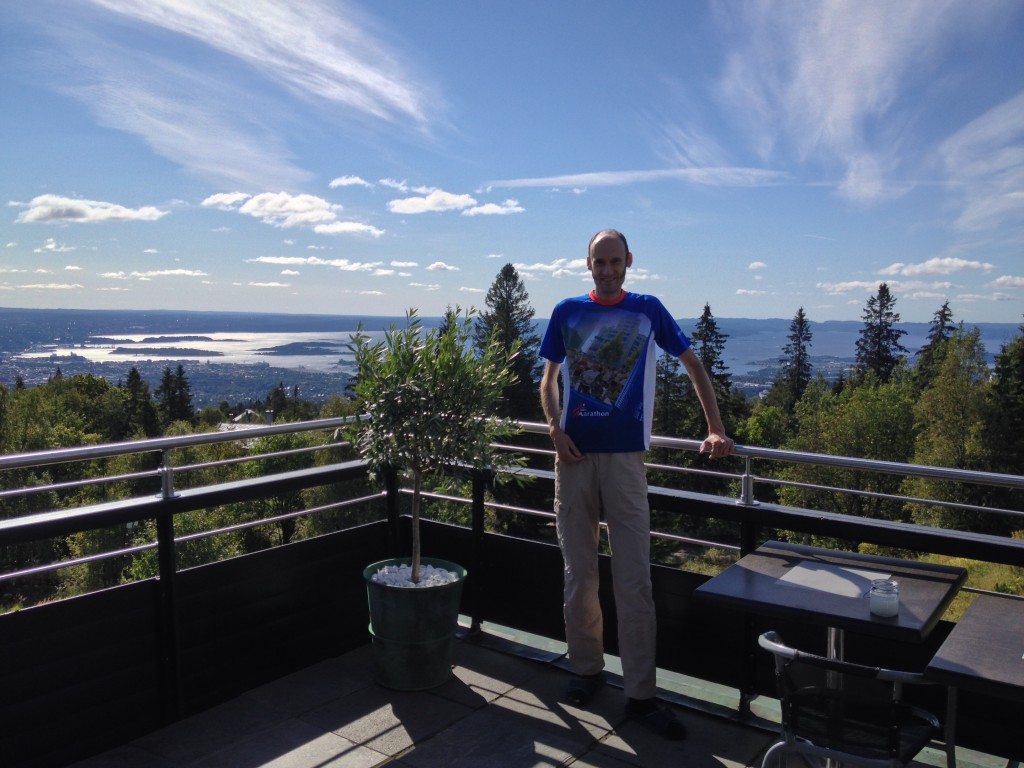
The hotel is outside the city center on a hill in a forest, the place is ideal as a starting point for all kinds of walks. I intend to explore the area.
In the Olympic winter park, north of the hotel, a complete climbing route is made with ropes and ladders in the trees. Everyone young and old joins. Along the wooded route I pass several lakes and restaurants. It is a true area for hiking and cycling. Also at the eateries along the way, you only see people who have come on their own. No parking lots stuffed with cars. No, nothing like that. Only sporty dressed people and lots of mountain bikes.
At the end of the afternoon I have walked 18km which has made me hungry. But tonight there is no dinner at the hotel, so I decide to drive into town. I get some advice from the reception of the hotel where the restaurants are, and where I can park best. When I have arrived, I follow the signs to a parking garage. It seems to be a Q-park.  That sounds familiar, because in the Netherland I also park there regularly. But when I enter inside, it doesn´t look as I am used to. Everything is narrow, old and messy. Despite that, I see a sign which indicates charging spots down in the basement. I would not expect that here. And then, when I want to drive downwards, suddenly all windows are fogging. I quickly turn on the fan, but strangely enough, that does not help. It seems the fogging is on the outside of the windows! When opening the window I notice the air in here is extremely humid, which explains why it condensates directly on the cool car. Perforce I drive further down with the wipers on. Arriving at the chargers I park, and look what connection they have here. There appear to be some very rickety outlets on the wall. Given the extremely moist condition here, I will not dare to plug in my Zoe. In fact, I´m will not park at all in this damp basement. So I get back in the car, and drive on. But after I´ve driven two circles in the wet basement, I cannot find the exit. Okay, then I will use the entrance to get out. That seems to be the only way to get out of here. Finally I park as close as possible to the exit of the garage.
That sounds familiar, because in the Netherland I also park there regularly. But when I enter inside, it doesn´t look as I am used to. Everything is narrow, old and messy. Despite that, I see a sign which indicates charging spots down in the basement. I would not expect that here. And then, when I want to drive downwards, suddenly all windows are fogging. I quickly turn on the fan, but strangely enough, that does not help. It seems the fogging is on the outside of the windows! When opening the window I notice the air in here is extremely humid, which explains why it condensates directly on the cool car. Perforce I drive further down with the wipers on. Arriving at the chargers I park, and look what connection they have here. There appear to be some very rickety outlets on the wall. Given the extremely moist condition here, I will not dare to plug in my Zoe. In fact, I´m will not park at all in this damp basement. So I get back in the car, and drive on. But after I´ve driven two circles in the wet basement, I cannot find the exit. Okay, then I will use the entrance to get out. That seems to be the only way to get out of here. Finally I park as close as possible to the exit of the garage.
Then I walk into town, and find a nice restaurant “Peppes Pizza”, where I enjoy a big vegetarian pizza along with a salad.
7-9-2015 Oslo: Holmenkollen
At the road to the hotel there is the Holmenkollbakken, a famous ski jump where competitions were held since 1892 and in 1952 even the Winter Olympics. Again it’s wonderful sunny weather, so a hiking tour and a visit to this ski jump are planned. At the Holmenkollen is also a museum, where they have small scale models that show the changing of the slope over the years beautifully, and how it got higher each time. An elevator goes diagonally upwards through the shaft to the top of the ramp. This is the same elevator that also carries the ski jumpers. From the top you have a beautiful view of the surroundings and Oslo, and you get a good impression of how it must be if you are about to jump with skis from it.

After visiting the ramp I continue the tour and stop by the restaurant Frognerseteren where I enjoy a delicious tomato mozzarella pesto salad, and a small veggie quiche. From there it is not very far back to the hotel.
In the evening there is ample dinner, for now my last dinner in Norway, because tomorrow I have ahead the long journey through Sweden to København.
8-9-2015 Oslo – København [621km]
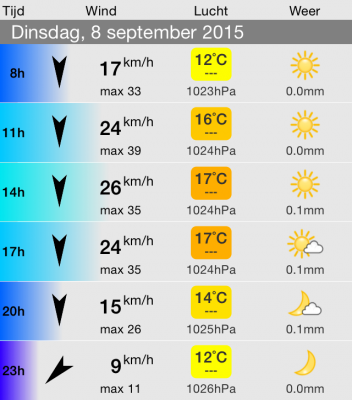
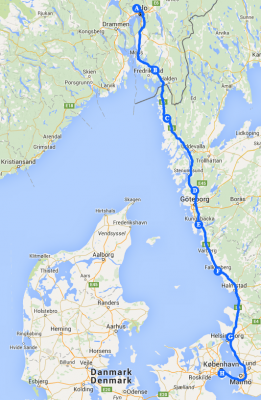 Today I have the longest stage of my vacation before me. But I have one advantage: tailwind, resulting in lower energy consumption and thus slightly shorter charging stops. The first three stops are all quick chargers, situated on nice intervals. The first one is in Sarpsborg, the second in Tanumshede at a large shopping center, and then in Kungälv, where a Tesla driver frees up the AC charge plug for me. Next I check out the charger in the city Kungsbacka, because it is unclear what power it can deliver. It seems to be only 3,7kW. After a short calculation I know that the 11kW charger in Falkerburg is within reach, and that one is 3 times as fast. I have agreed upon with Jens, the ‘Miljöchef’, that I will call him on his mobile when I’m there, so I can get a pin code from him to activate the charge pole. I hope it goes well, because I do not have an alternative. But to be on time in København I need at least an 11kW charger. So I choose for that option. Upon arrival in Falkenberg I call him. He will arrange it.
Today I have the longest stage of my vacation before me. But I have one advantage: tailwind, resulting in lower energy consumption and thus slightly shorter charging stops. The first three stops are all quick chargers, situated on nice intervals. The first one is in Sarpsborg, the second in Tanumshede at a large shopping center, and then in Kungälv, where a Tesla driver frees up the AC charge plug for me. Next I check out the charger in the city Kungsbacka, because it is unclear what power it can deliver. It seems to be only 3,7kW. After a short calculation I know that the 11kW charger in Falkerburg is within reach, and that one is 3 times as fast. I have agreed upon with Jens, the ‘Miljöchef’, that I will call him on his mobile when I’m there, so I can get a pin code from him to activate the charge pole. I hope it goes well, because I do not have an alternative. But to be on time in København I need at least an 11kW charger. So I choose for that option. Upon arrival in Falkenberg I call him. He will arrange it.  Moments later he calls me back and gives me the 6-digit pin code. I enter the code on the keypad of the charge pole and a few seconds later I hear “click”. Hurray, charging begins! Now I only have to wait one and a half hour. This is still a weak spot in the entire route, because all other distances are covered with 22kW or 43kW chargers. For now I’m glad this charging point exists, because the next one is only after 111km in Ödåkra at IKEA. Actually, it’s a good thing I’m here with a Renault Zoe, because most other electric cars (Tesla Model S excluded) can only use 1 fase charging on an 11kW station, which takes 3 times as long. The chameleon charger in the Zoe which is able to charge with 3 to 43kW AC power, proves itself again.
Moments later he calls me back and gives me the 6-digit pin code. I enter the code on the keypad of the charge pole and a few seconds later I hear “click”. Hurray, charging begins! Now I only have to wait one and a half hour. This is still a weak spot in the entire route, because all other distances are covered with 22kW or 43kW chargers. For now I’m glad this charging point exists, because the next one is only after 111km in Ödåkra at IKEA. Actually, it’s a good thing I’m here with a Renault Zoe, because most other electric cars (Tesla Model S excluded) can only use 1 fase charging on an 11kW station, which takes 3 times as long. The chameleon charger in the Zoe which is able to charge with 3 to 43kW AC power, proves itself again.
When I arrive at 18:30 at IKEA, I see from a distance a BMW i3 being parked near the 22kW charger, and I really want to charge quickly, because I only have 10% in the battery left!
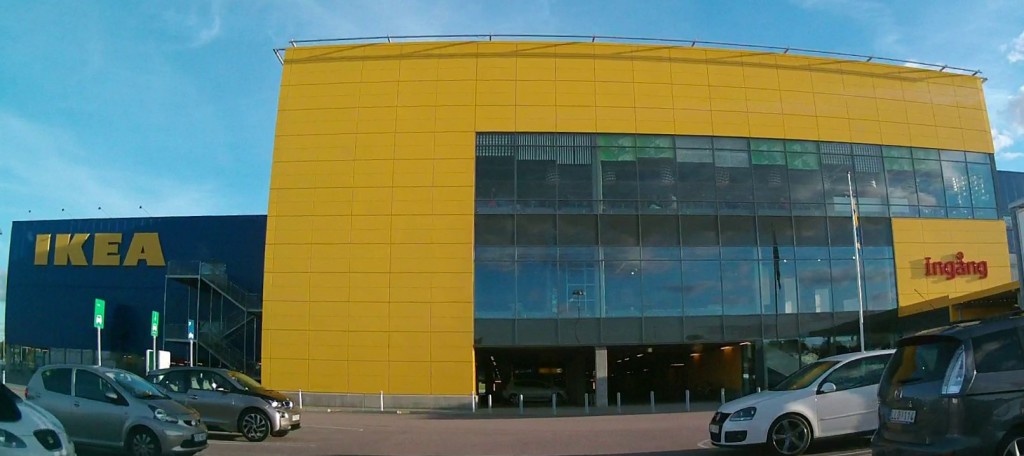
But luckily for me he uses the other charger, so the semi-quick charger is still free. From here it is only just over 100km to København, so this is the last stop on the way.
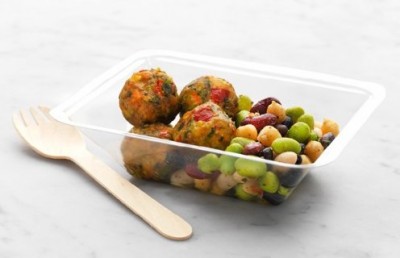 I have almost one hour to spend, and not eaten at IKEA yet. So it’s about time to try typical Swedish food. I order “Grönsaksbullar med bönsallad” (Veggie balls served with a mixed bean salad). It is very tasty and healthy too.
I have almost one hour to spend, and not eaten at IKEA yet. So it’s about time to try typical Swedish food. I order “Grönsaksbullar med bönsallad” (Veggie balls served with a mixed bean salad). It is very tasty and healthy too.
At half past 7 I am on my way again, to leave Sweden by the Øresund Bridge while being treated to a beautiful sunset, which is captured nicely by my dashcam.
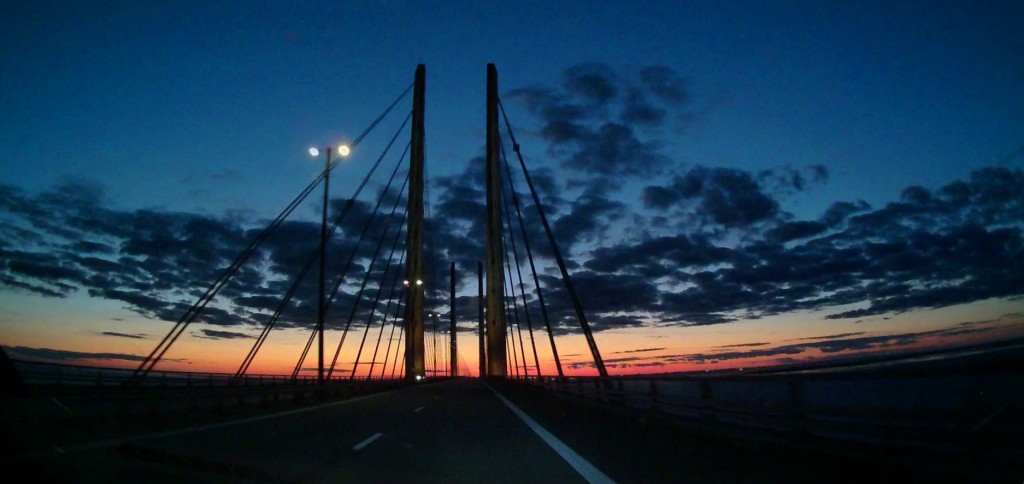
At 20:30 I arrive at the hotel in København, just in time to order a pizza at restaurant Milano. While eating, Zoe is also being charged at the very green charging pole of Clever.
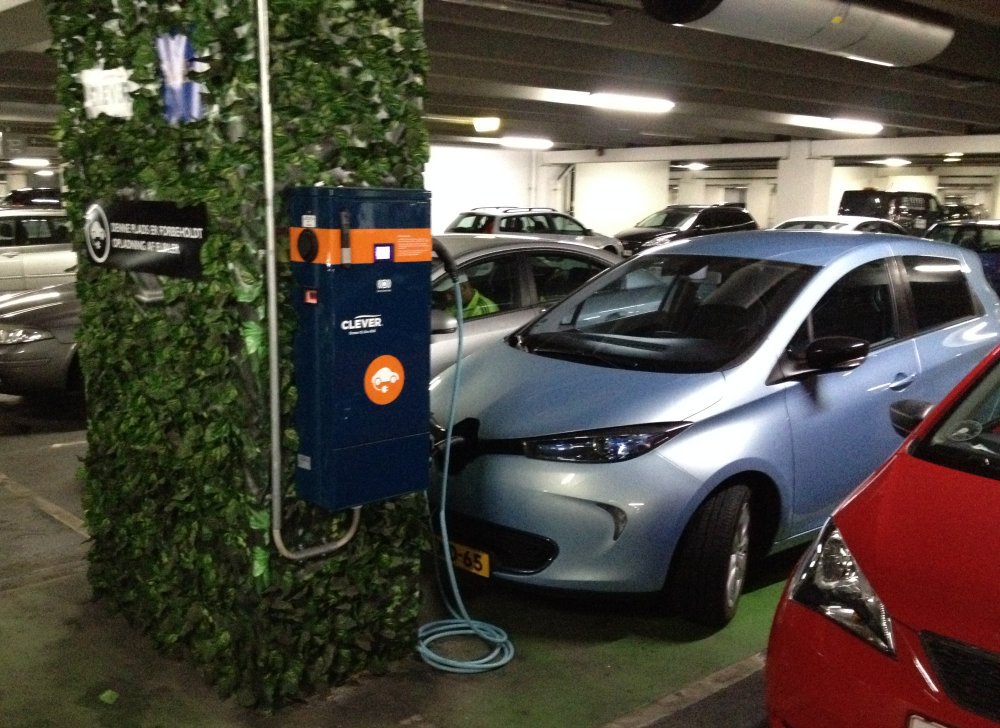
9-9-2015 København – Hamburg [479]
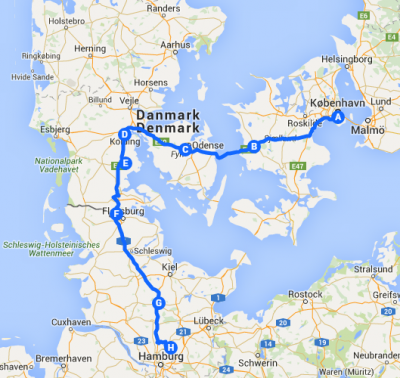 Both on the outward and return journey I use in Denmark charging points of Clever only. I could also use some of E.ON, but as a foreigner you can only pay by credit card using your phone, where you pay a relatively high fixed price. That’s why I have skipped those for now. Through Slagelse, Odense, Kolding and Haderslev the trip proceeds well. Until 20km before Padborg the highway is suddenly closed.
Both on the outward and return journey I use in Denmark charging points of Clever only. I could also use some of E.ON, but as a foreigner you can only pay by credit card using your phone, where you pay a relatively high fixed price. That’s why I have skipped those for now. Through Slagelse, Odense, Kolding and Haderslev the trip proceeds well. Until 20km before Padborg the highway is suddenly closed.
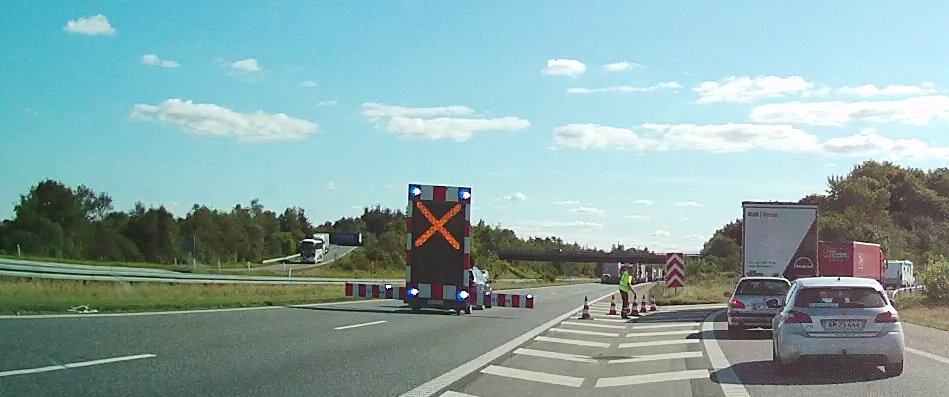
All vehicles must leave the highway, and then you have to figure it out for yourself. I quickly zoom out on the map of the navigation again, and choose a road that also leads to the next charging point. 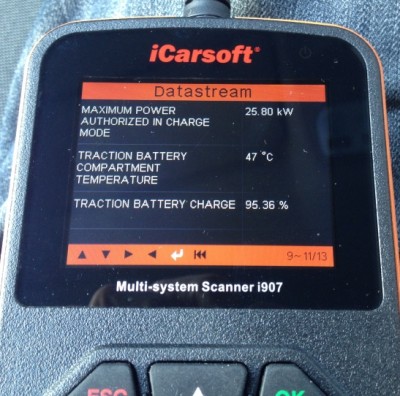 This appears to be the road that most people take, yet the traffic still flows reasonably. I agreed with Marc to meet at 17:00 in Neumünster, to pick up a package that needs to go to the Netherlands. Despite the delay, I arrive right on time. While Zoe is connected to the quick charger, we load the stuff in my car. During charging I see the battery temperature has risen to a new record: 47°C! Measurements show that at such high temperatures, the speed of charging will be somewhat limited in order to protect the battery from overheating.
This appears to be the road that most people take, yet the traffic still flows reasonably. I agreed with Marc to meet at 17:00 in Neumünster, to pick up a package that needs to go to the Netherlands. Despite the delay, I arrive right on time. While Zoe is connected to the quick charger, we load the stuff in my car. During charging I see the battery temperature has risen to a new record: 47°C! Measurements show that at such high temperatures, the speed of charging will be somewhat limited in order to protect the battery from overheating.
At 18:30 I arrive at Landhaus Ohlstedt in Hamburg, a particularly nice hotel situated close to a large forest.
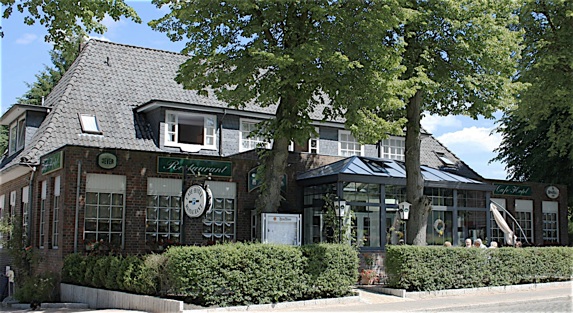
At the back of the hotel I may charge my car for free to a household socket.
10-9-2015 Hamburg – Thuis [455]
The weather is beautiful, and before I start the final leg back home, I first go for a nice jog in the woods. I don’t care if I come home just a little later. After all it’s my holiday. I was able to arrange with the cleaning ladies to do my room last, so I can take a quick shower after jogging before I leave.
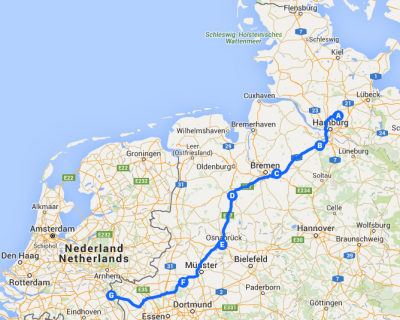 At 12:00 I have loaded all my luggage into the Zoe, time to go home. The first stop is along the A1 in Neu Wulmstorf at McDonald’s. At first I cannot find the charging station, but it appears that a large fossil BMW is parked on the only charging spot here, and the charger is placed in such a way that I cannot reach it from another spot. So I park my car close behind it, photograph the license plate, and walk inside McDonald’s. I explain the situation, and ask if they can broadcast the license plate. That turns out not to be possible, or they do not want to do it. But I do not want to sit and wait until the BMW driver is back, so I ask if she can activate the charger while my car is parked behind it.
At 12:00 I have loaded all my luggage into the Zoe, time to go home. The first stop is along the A1 in Neu Wulmstorf at McDonald’s. At first I cannot find the charging station, but it appears that a large fossil BMW is parked on the only charging spot here, and the charger is placed in such a way that I cannot reach it from another spot. So I park my car close behind it, photograph the license plate, and walk inside McDonald’s. I explain the situation, and ask if they can broadcast the license plate. That turns out not to be possible, or they do not want to do it. But I do not want to sit and wait until the BMW driver is back, so I ask if she can activate the charger while my car is parked behind it. 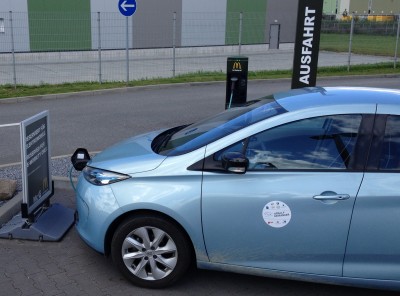 We can then interrupt the charging when he comes back. After much insistence it is consented. As we walk out together, it seems the driver already returned at his car. He says he did not see the sign. Yeah right… He almost ran over the sign, which brings the message very clearly. Anyway, I let him go, so I can at least charge.
We can then interrupt the charging when he comes back. After much insistence it is consented. As we walk out together, it seems the driver already returned at his car. He says he did not see the sign. Yeah right… He almost ran over the sign, which brings the message very clearly. Anyway, I let him go, so I can at least charge.
The next piece of highway has only an advisory speed of 130 km/h, and the next charger is just 67km away. This is a nice opportunity to test the top speed of the Zoe. The limiter kicks in at 141 km/h on the clock. (In reality, the speed is 137 km/h.)

The power to keep this speed fluctuates around 33kW. That’s about the same power needed by 15 electric kettles. The energy consumption results in 240 Wh/km. And if you include the charging losses, it is even 274 Wh/km. The range at this speed is only 92 km, which is about half of what is possible if you would drive 80 km/h constantly. In other words, a clear example that high speed really takes a lot more energy.
After stops in Oyten and Emstek I arrive at the fast charger in Osnabrück. But, what happened here? I hardly recognize the place! The area or the charger is completely blocked and is being renovated. I park the car along the fences, and check out the charger. It is still active, but the question is if I can still reach it by car? The pavement is removed, but the subsoil does feels firm, and at the end of the gates, there is a small opening. I don’t feel like having to find another charger nearby that is less fast, so I take the risk and drive through the small opening as close to the station as possible. The cable is just long enough, and the charger luckily works fine.
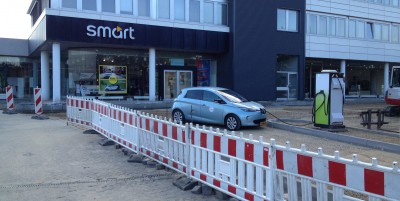
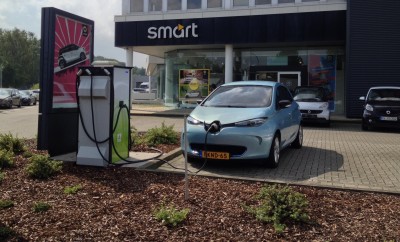
Left: during the renovation. Right: as it looked before.
After Osnabrück I can choose two routes. The safe route by Hengelo and Arnhem with Fastned chargers, or the shorter route by Münster and Wesel with still unknown charging poles. With everything I’ve been through on my journey I dare to take a chance, and take the shortest route. If everything goes well, I only have to charge once.
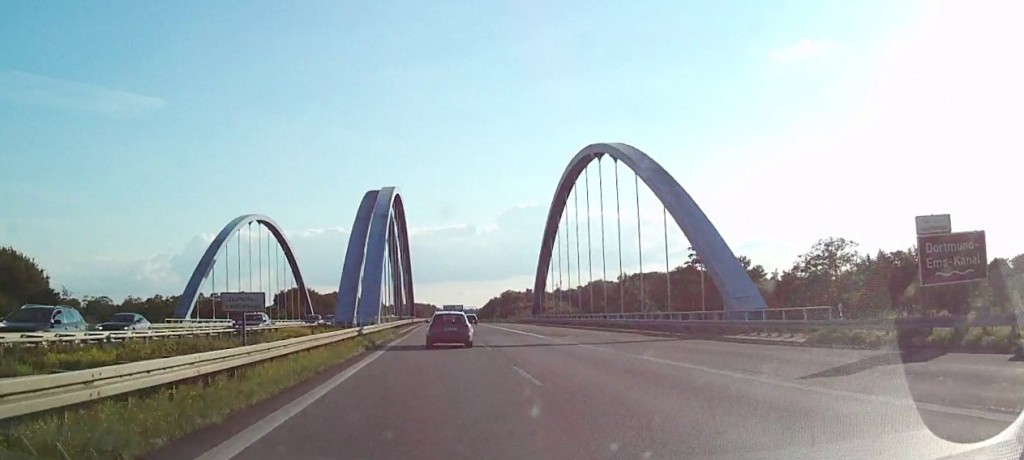
Dortmund-Ems-Kanal.
When I arrive at the charger in Dülmen, it appears to be placed exactly between two vacuum parking spaces, which happen to be occupied both.
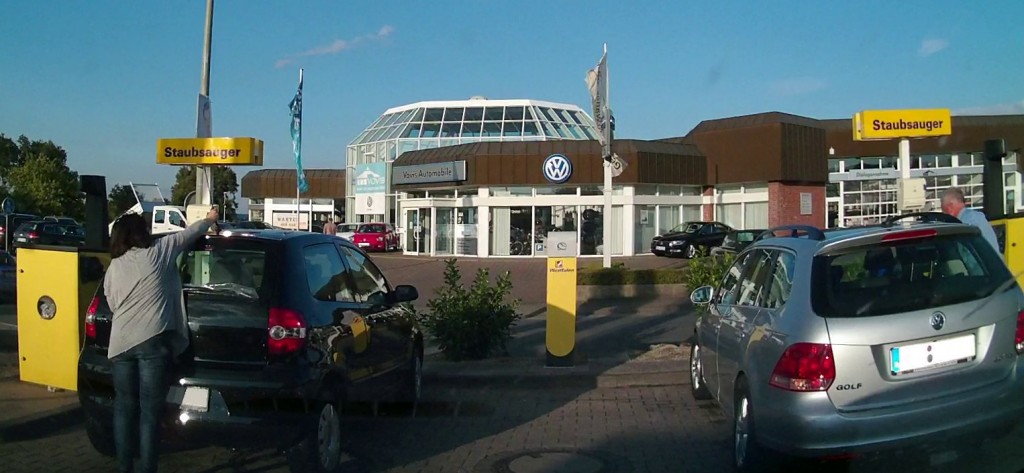
But luckily they are both ready soon, and then I connect my Zoe to the left socket of the RWE charge pole. But then things go wrong. The indicator in the nose of the Zoe turns red, and the famous message “Battery charging not possible” appears on the display! Even when I connect the plug to the other side of the pole, the indictor turns red immediately. Is this really happening at the last charger before getting home? I do a reset by closing the car, and wait for 5 minutes. Then I try it again by connecting the plug to the right side of the pole. If it fails, I go to another charging station close by. But now the indicator in the nose of the Zoe stays blue, and a few seconds later I hear by the typical high pitch sound the charging has started. The left socket probably has a malfunction, but the other side luckily is okay.
By taking the highway it would still be up to 134km till home, but to take no more risk, I will take a shorter road via Wesel (B58). This will save me 20km.
At 19:40 the battery level is 99%, good to go. Around half past 8 I cross the blue lit bridge near Wesel, with a beautiful sunset glow on the horizon.
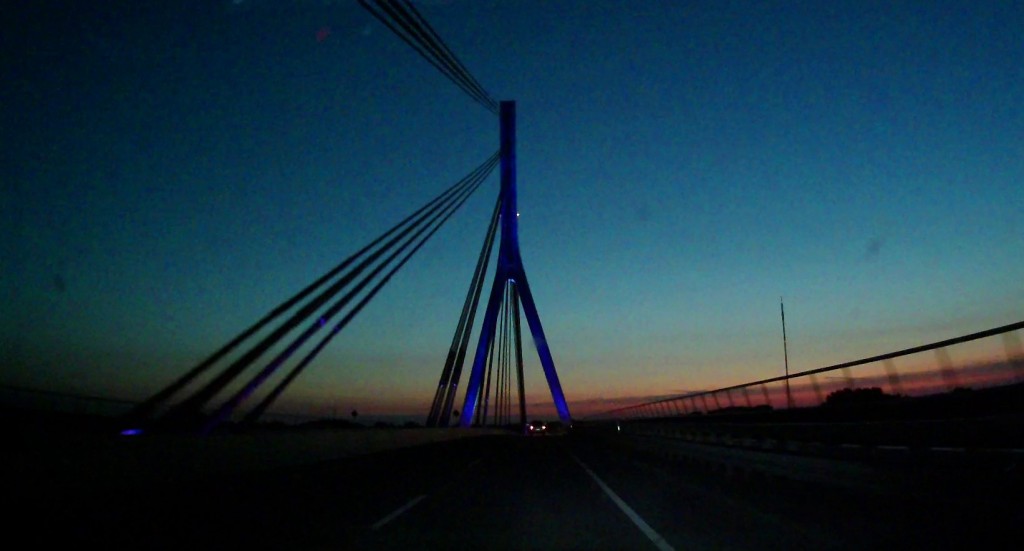
15 minutes later, with 10% battery charge left, I am home, and have completed 4400km in total!
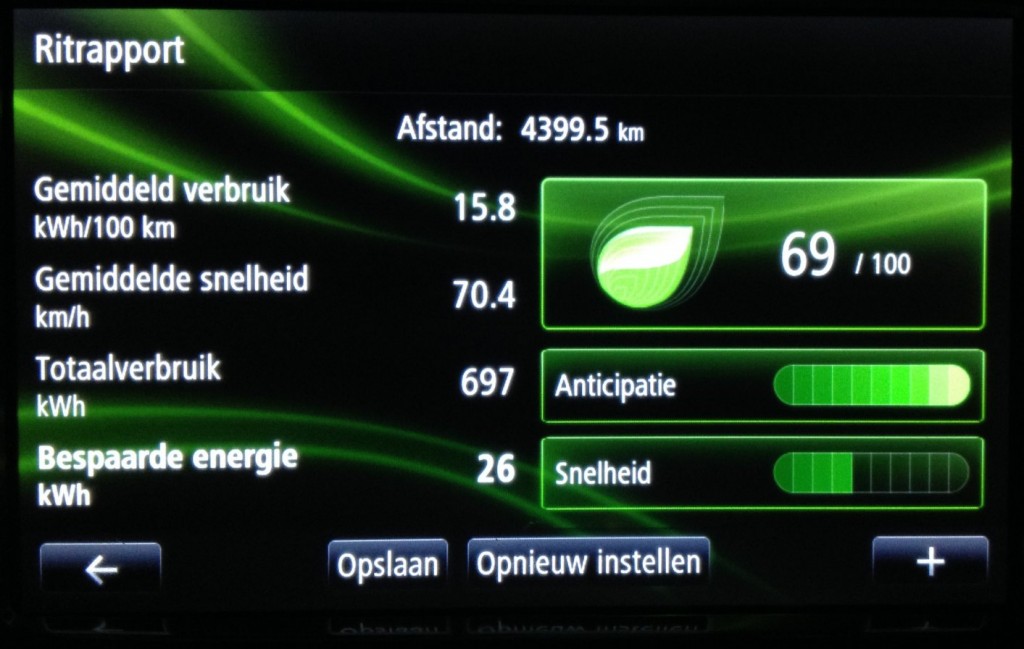 (Distance, Average consumption, Average speed, Total consumption, Regenerated energy)
(Distance, Average consumption, Average speed, Total consumption, Regenerated energy)
Epilogue
The Charging pauses my Zoe regularly suffered from during the holidays, have been resolved by a software update performed at the Renault dealer. So from now on I will have shorter charging stops at future long distance drives, which will give me a higher average speed (including charging) than before.
The Norwegian electric car association still has the picture, where my Zoe is in the center, on the cover of their Facebook. I feel honoured.
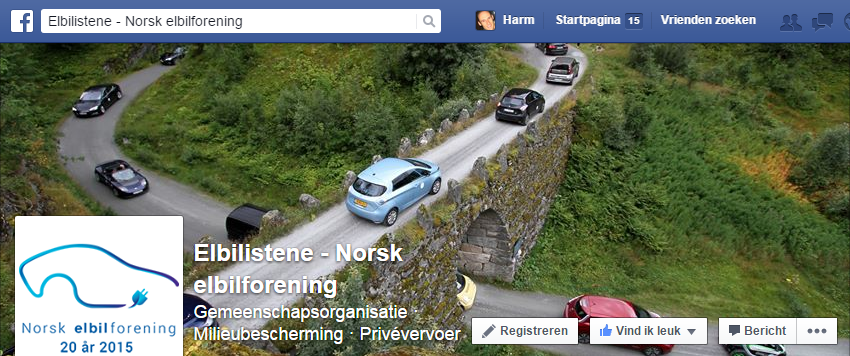
 The little crown of the pineapple survived the journey as well, and is resting in a little pot, so it can form roots and grow into a new pineapple plant 🙂 .
The little crown of the pineapple survived the journey as well, and is resting in a little pot, so it can form roots and grow into a new pineapple plant 🙂 .
Conclusion
During this trip I deliberately tested the limits of the current charging network. Despite some issues, I still was able to reach all the places I wanted to go.
In the future there will be more and better charging stations installed, making this kind of traveling easier.
A drawback is the variety of charge cards and Apps that you need in foreign countries in order to be able to charge. Improvements are being worked on.
Numbers
Total driven distance: 4401.5 km
Total number of charges: 55
Total charged energy: 808.222 kWh
Total consumption: 697 kWh
Charging losses: 13.8%
Average consumption (including charging losses): 183.62 Wh/km
Average consumption (without charging losses): 158 Wh/km
Total charging cost: €194.06
| Date d-m-yyyy |
Trip | Distance | Time | Average speed including charging |
|---|---|---|---|---|
| 24-8-2015 | Gennep – Lübeck | 575 km | 08:00 – 19:00 (11 hours) | 52.3 km/h |
| 25-8-2015 | Lübeck – København | 477 km | 09:00 – 19:15 (10¼ hours) | 46.5 km/h |
| 26-8-2015 | København – Sarpsborg | 535 km | 09:00 – 22:00 (13 hours) | 41.2 km/h |
| 28-8-2015 | Sarpsborg – Geiranger | 540 km | 09:40 – 22:10 (12½ hours) | 43.2 km/h |
| 1-9-2015 | Geiranger – Hjelle | 48 km | ||
| 5-9-2015 | Hjelle – Oslo | 460 km | 09:30 – 21:30 (12 hours) | 38.3 km/h |
| 8-9-2015 | Oslo – København | 621 km | 08:30 – 20:30 (12 hours) | 51.8 km/h |
| 9-9-2015 | København – Hamburg | 479 km | 09:30 – 18:30 (9 hours) | 53.2 km/h |
| 10-9-2015 | Hamburg – Gennep | 455 km | 12:00 – 21:15 (9¼ hours) | 49.2 km/h |
Preparation
Charge cards:

Apps on the phone:
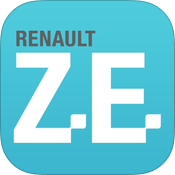
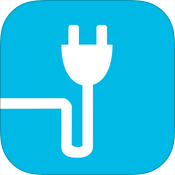

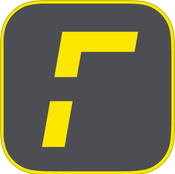

From left to right: Renault ZE, ChargeMap, e-kWh for RWE chargers in Germany, Fastned, goCharge (Norway).
Additional 3 phase mobile charger, also suitable for a normal household socket:
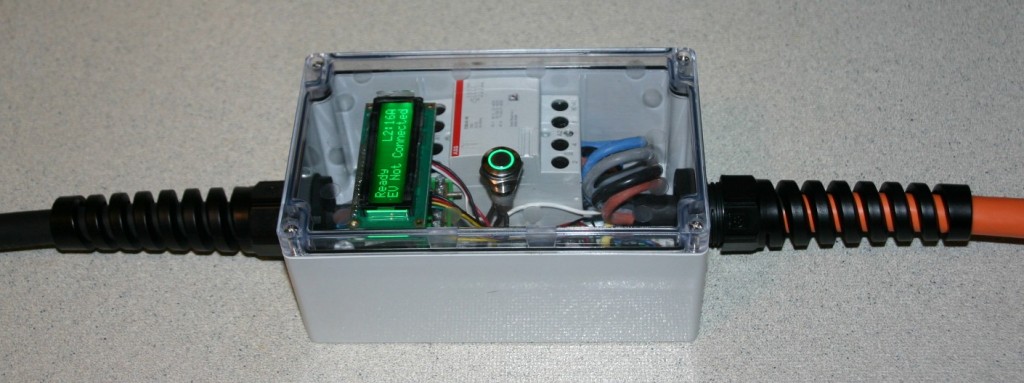

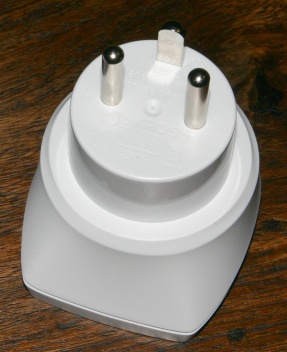
(This time I only used the normal household plug.)
Register Credit card at Autopass for the tollgates in Norway.
Book hotels via Trivago and Booking.com. The advantage is that all your hotels are on your phone in one App, and you have the possibility to cancel or change until 24 hours in advance.
Word of thanks
The following companies, hotels and persons have made the trip possible for me. Many thanks!
Norsk elbilforening [www.elbil.no]
Fortum [www.fortum.no]
Grønnkontakt [gronnkontakt.no]
Clever (Denmark) [www.clever.dk]
Jens Melin of Energi Bjuder Falkenberg (Sweden)
Statoil
EWE (Germany) [www.ewe.de]
Fastned (Netherlands) [www.fastned.nl]
Filip van Rickstal [www.fivari.be] (Creator of the 3 phase mobile charger)
Renault Sweden
Renault Netherlands
Lilian Wijnhoven
Links
Norsk elbilforening: Uitnodiging EV festival in Geiranger!
Norsk elbilforening: From the Netherlands to Geiranger: – No problem!
tu.no: Harm (44) kjørte elbil fra Nederland til Geiranger
Norsk elbilforening: eRally article
Youtube: eRally Geiranger 2015: Taking electric vehicles out of town!
Norsk elbilforening: Many saw the video already




